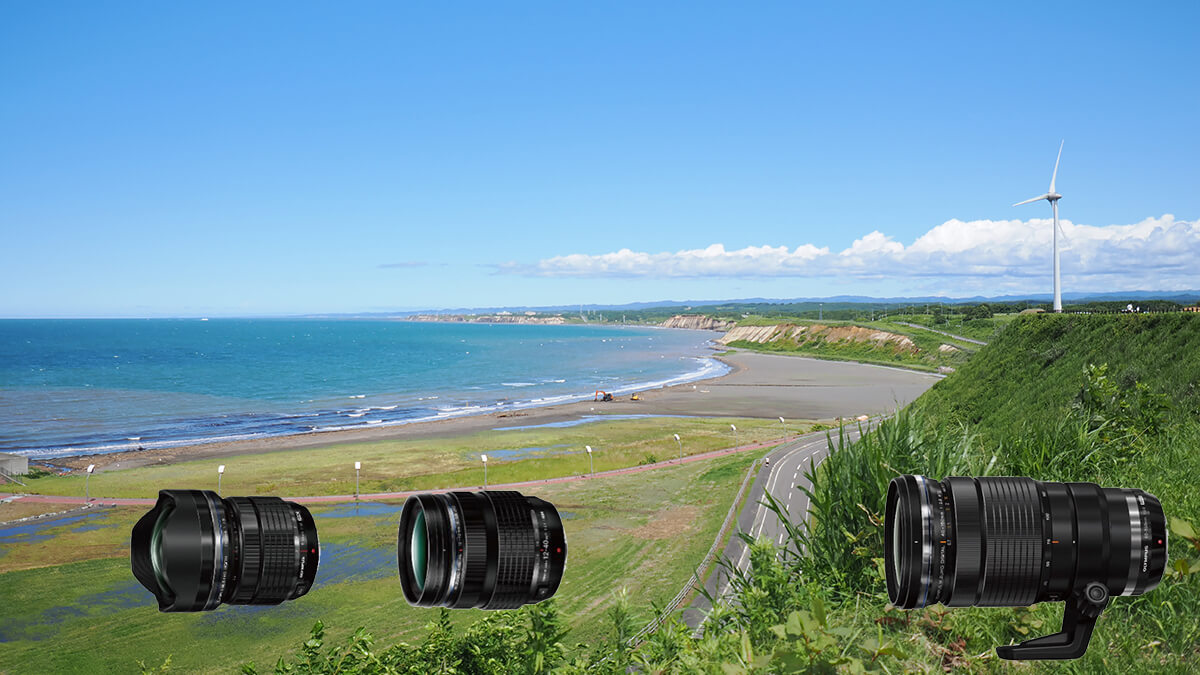
[A beautiful driving course that Hokkaido residents love! 】I took a look at the "Ororon Line" that you should remember in preparation for uneven weather conditions, with OM SYSTEM Large Three-Model Lens
Hokkaido is in the middle of the tourist season, but the weather is not stable this year. Even the author, who lives in Hokkaido, may not be able to find sunny weather as he had hoped. So I thought I was in Furano and Biei, but in preparation for the weather, I went around the Ororo Line, which I should remember, with the OM SYSTEM major three-man lens, so I'd like to report on it.
table of contents
- What is the Ororon Line, a driving course that has been praised by Hokkaido residents?
- Why do we recommend the OM SYSTEM Large Three-Model Lens?
- Furano, Biei - I was planning to film the Naki Rabbit
- The Ororon Line is a beautiful landscape, with a wide range of roadside stations, hot springs and campsites.
- Must-see points for Ororon Line
- Tomamae's "Sankebetsu Bear Incident Restoration Site" - seven people died, and the site of the worst animal damage incident in Japanese history
- Hatsuyamabetsu Konpira Shrine is a beautiful torii gate that is perfect for daytime, sunset, and star times.
- Wakkanai "Souya Cape" Cape at the northernmost tip of the main island of Hokkaido
- I like the fantastic atmosphere of the night view of Wakkanai's "North Breakwater Dome"
- Enjoy both the sunset and sunrise at Wakkanai Cape Soya
- I also visited "Temaijima", a remote island in Hokkaido and is said to be a paradise for wild birds.
- I went to Tenmijima, a remote island in Hokkaido, a paradise for wild birds.
- A second-class ferry can take you to a remote island from Haboro for around 2,500 yen each way.
- Walking around Temijima, about 12km arc, with OM SYSTEM "OM-1 Mark II" and a large three-man lens
- I've also been able to photograph Ororon birds (sea glass), which are on the verge of extinction.
- It's so much fun, I'd like to stay overnight in June next season
- Summary: OM SYSTEM "OM-1 Mark II" + Daisangen lens is perfect for adult adventures
- Details and purchase of OM SYSTEM cameras and lenses
What is the Ororon Line, a driving course that has been praised by Hokkaido residents?
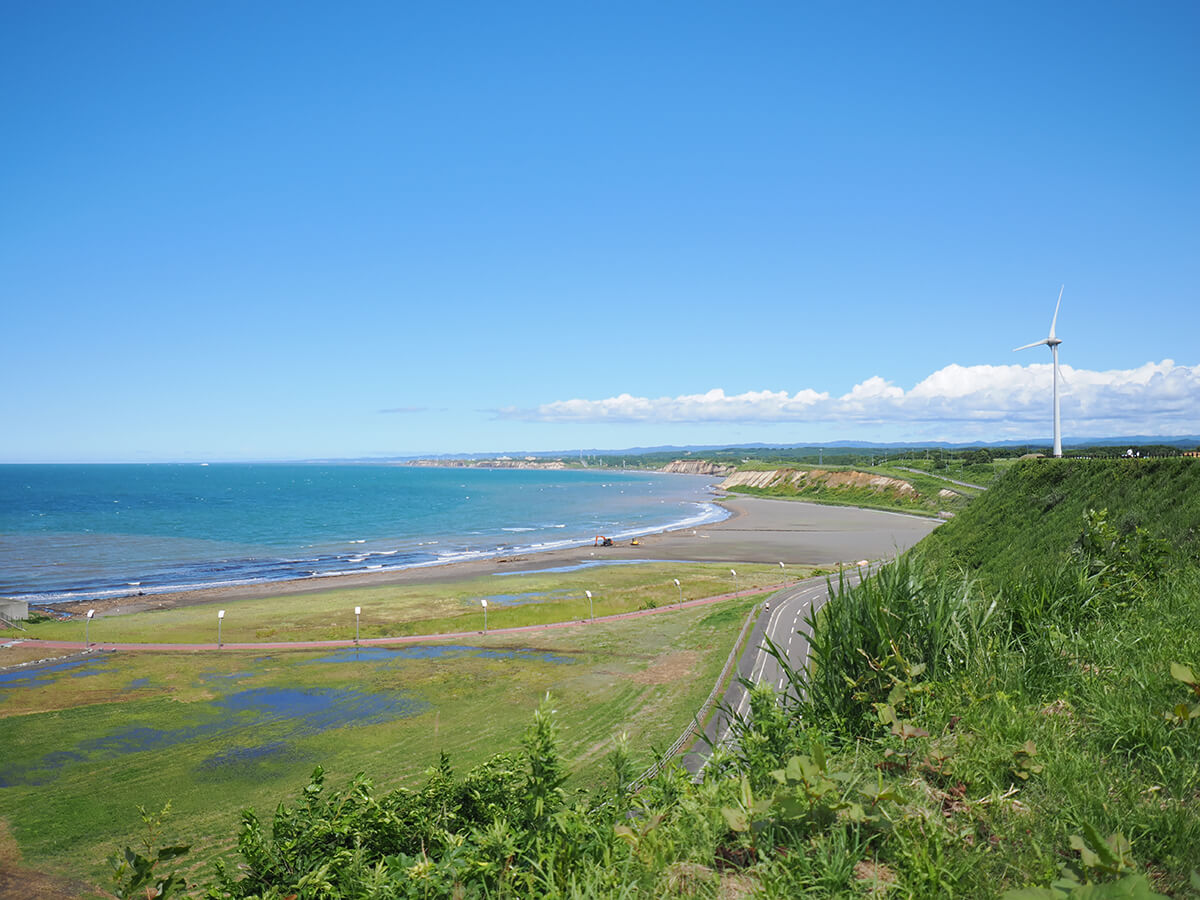
M.ZUIKO DIGITAL ED 7-14mm F2.8 PRO/OM SYSTEM OM-1 Mark II/Equivalent to 28mm (35mm format equivalent)/Aperture priority AE (F2.8, 1/3,200 seconds)/ISO 200/Exposure compensation: +0.7EV/WB: Sunny weather/Picture mode: Vivid
The summer of the Ororon Line, running along the beautiful scenery along the Sea of Japan, is truly refreshing.
Route along the Sea of Japan from Otaru and Ishikari to Cape Soya
Most people probably don't know about it when they say "Ororoline." However, this is one of Hokkaido's leading driving courses, where many Hokkaido residents say, "Driving on the Ororon Line in the summer is the best!"
Specifically, if you roughly consider Hokkaido, excluding the southern part of Hokkaido, it is a diamond shape, then the Ororon Line runs along the top left side. The route runs along the Sea of Japan from the slightly north side of Sapporo, Otaru or Ishikari city, from the northernmost tip of Hokkaido's main island, and Cape Soya in Wakkanai city.
This "Ororon Line" is a route that runs along the beautiful coastline around 350km along the Sea of Japan, and even Hokkaido residents who are used to driving around Hokkaido usually feel the richness and vastness of Hokkaido's nature while driving along the Ororon Line in sunny summer weather.
Is the reason why I would like you to remember this "Ororon Line" all over the country recently? Globally? The weather seems unstable, and the weather in Hokkaido in 2024 is unstable. However, in Hokkaido, which is said to be larger than small European countries, you can move to a place with nice weather by changing your destination within Hokkaido. In such cases, it is recommended to remember the "Ororon Line" as a driving route north of Hokkaido on the Sea of Japan side.
Why do we recommend the OM SYSTEM Large Three-Model Lens?
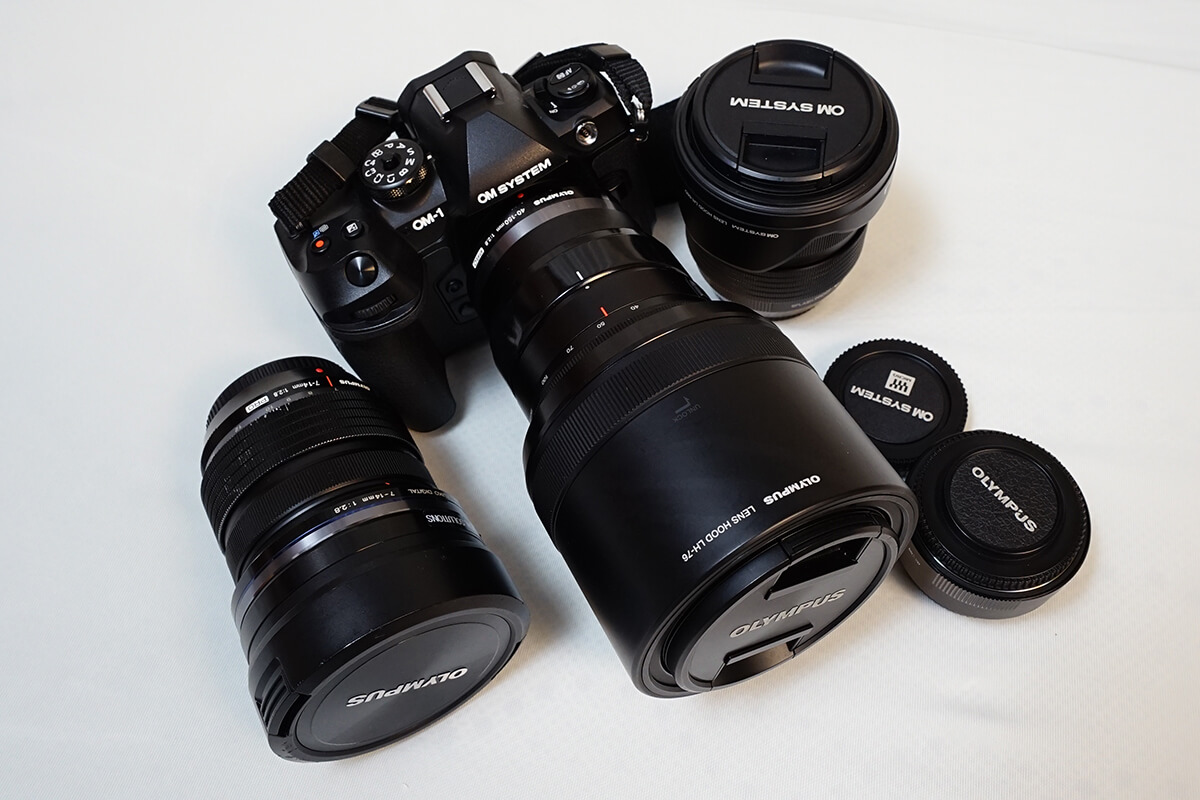
Even if you add three large three-unit lenses to the OM-1 Mark II and a double teleconverter, the lens and camera weigh around 2kg. Its overwhelming lightness is attractive.
Ultra-lightweight and compact, fully equipped with a cover of 14mm to 600mm equivalent.
As a photographer writer, I am an extremely trusted person in terms of mobility, OM SYSTEM's camera and lens system is an OM SYSTEM. Incidentally, OM SYSTEM is a brand that has taken over the DNA of OLYMPUS, which was established in 2021 with its video division independently from OLYMPUS. In general, the basic principle of many professional photographers' camera and lens systems is the Daisangen lens. It is a bright zoom lens with an F2.8 passing through, and is called a large three-way lens: a wide-angle zoom of around 15mm to 35mm equivalent, a standard zoom of around 24mm to 70mm equivalent, and a telephoto zoom of around 70mm to 200mm equivalent. This is often the case that macro lenses or ultra-telephoto lenses are added to this, and that camera and lens systems are fundamental to camera and lens systems, regardless of camera manufacturer or system.
Of course, when I go on a filming trip or filming, I choose a camera system based on this professional camera body and a large three-way lens. But in reality it's quite heavy. The 35mm full-size high-end camera body for professionals usually weighs over 1kg, and each large three-unit lens weighs around 1kg, so this alone costs around 4kg. Furthermore, accessories such as lens caps, lens hoods and tripod seating are available, so the weight is around 5kg.
In contrast, the OM SYSTEM high-end camera body "OM-1 Mark II" (599g), the wide-angle zu-zoom "M.ZUIKO DIGITAL ED 7-14mm F2.8 PRO" (534g), the standard zoom "M.ZUIKO DIGITAL ED 12-40mm F2.8 PRO II" (382g), and the telephoto zoom "M.ZUIKO DIGITAL ED 40-150mm F2.8 PRO" (760g), and the telephoto zoom "M.ZUIKO DIGITAL ED 40-150mm F2.8 PRO" (760g), and the F2.8 weighs just over 2kg, covering the wide-angle end equivalent to 14mm to 300mm. This is very important considering how you should carry it with your back.
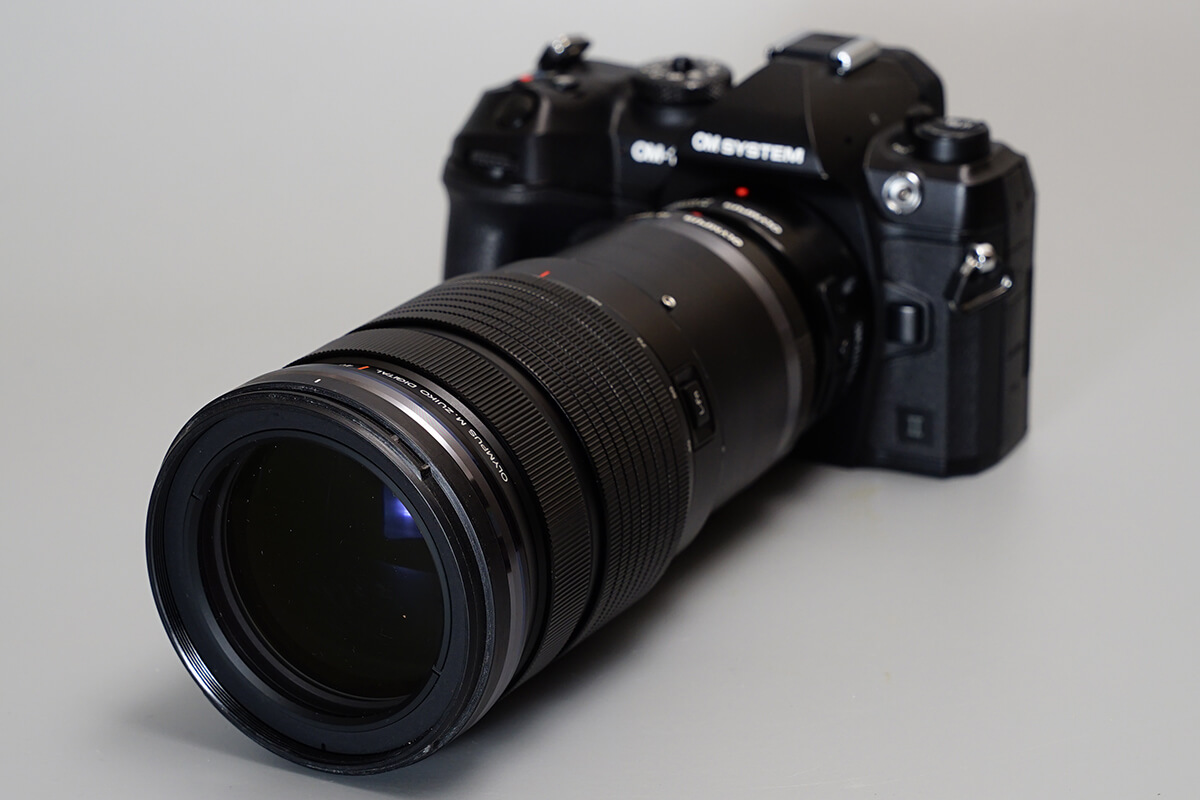
This is an extra one of the OM SYSTEM large three-model lens systems, but my favorite is the M.ZUIKO DIGITAL ED 40-150mm F2.8 PRO + M.ZUIKO DIGITAL 2x Teleconverter MC-20 and the OM SYSTEM OM-1 Mark II. Surprisingly lightweight and compact.
Also, considering that wild birds and wildlife are photographed in Hokkaido, telephoto is not only 200mm, but also 300mm equivalent, which is quite unsatisfactory. However, using the M.ZUIKO DIGITAL ED 40-150mm F2.8 PRO, you can extend the telephoto end to 600mm equivalent, and even when it gets darker than the M.ZUIKO DIGITAL 2x Teleconverter MC-20 (150g), you can get a very high advantage of 600mm equivalent F5.6.
For me, who was thinking of photographing the landscape of Hokkaido in the summer and then finally climbing the mountains of the Daisetsu Mountains to photograph the Naki rabbits, the OM SYSTEM's "OM-1 Mark II" and large ternary lens make it an extremely attractive camera and lens system that makes it easy to take pictures like a single-focus super-telephoto lens with a 600mm equivalent F5.6. All of the cameras, lenses, and teleconverters are extremely tough, with dust and water resistant equivalent to IP53, and are extremely capable as a partner for outdoor and adult adventure scenes, not only for filming in Hokkaido. And in an age where a high-end camera body alone cost over 1 million yen, even if you buy a teleconverter with a camera body + large 3-gen lens, the price is around 700,000 yen, which is quite reasonable.
Incidentally, OM SYSTEM is holding the 2024 Summer Lens Fair on the 28th of August, and is running a cashback campaign worth up to 40,000 yen per item when purchasing eligible products. For details, please check this campaign page
Recommended points of the OM SYSTEM "OM-1 Mark II" and Daisangen lens
- Lightweight and compact, allowing you to trek in the scorching sun about 15km
- System weight is less than 3kg and covers 14mm equivalent to 600mm equivalent.
- All cameras, lenses and teleconverters are IP53 equivalent to dust and water resistant
- High quality unique to the M.ZUIKO DIGITAL PRO series
- Reasonable prices and high performance satisfaction that can be said to be within the scope of common sense
The key points that caught my eye about the OM SYSTEM "OM-1 Mark II" and the Daisangen lens
- The "MF clutch mechanism" that switches between AF and MF occasionally moves on its own
Main Specifications and ratings
| item | OM-1 Mark II |
|---|---|
| Effective pixel count | Approximately 20.37 million pixels |
| Quiet continuous shooting SH1 | Approximately 120 frames/sec |
| AI subject recognition AF | People/Cars, Motorcycles/Airplanes, Helicopters/Trains, Trains/Birds/Animals (Dogs, Cats) |
| Size and mass | Approx. 134.8mm x 91.6mm x 72.7mm, 511g (main unit only) |
| item | M.ZUIKO DIGITAL ED 7-14mm F2.8 PRO |
| Focal distance | 7-14mm (equivalent to 14-28mm in 35mm format) |
| Lens composition | 11 groups 14 pieces |
| Maximum shooting magnification | 0.12 times (equivalent to 0.24 times in 35mm format) |
| Size and mass | Φ78.9 x 105.8mm, 534g |
| item | M.ZUIKO DIGITAL ED 12-40mm F2.8 PRO II |
| Focal distance | 12-40mm (equivalent to 24-80mm in 35mm format) |
| Lens composition | 14 pieces for 9 groups |
| Maximum shooting magnification | 0.3 times (equivalent to 0.6 times in 35mm format) |
| Size and mass | Φ69.9×84mm・382g |
| item | M.ZUIKO DIGITAL ED 40-150mm F2.8 PRO |
| Focal distance | 40-150mm (equivalent to 80-300mm in 35mm format) |
| Lens composition | 16 pieces for 10 groups |
| Maximum shooting magnification | 0.21 times (equivalent to 0.42 times in 35mm format) |
| Size and mass | Φ79.4 x 160mm, 760g (excluding tripod seat) |
| item | M.ZUIKO DIGITAL 2x Teleconverter MC-20 |
| Lens composition | 4 groups 9 |
| magnification | Double |
| Size and mass | Φ59.8 x 25.90mm, 150g (excluding tripod seat) |
| OM SYSTEM's "OM-1 Mark II" and the Daisangen lens | |
| Lightweight and portable | ★★★★★ |
| Cover Focal Distance | ★★★★☆ |
| AF Performance | ★★★★☆ |
| toughness | ★★★★★ |
| Highly sensitive noise | ★★★☆☆ |
| Cost Performance | ★★★★☆ |
Furano, Biei - I was planning to film the Naki Rabbit
Considering mountain hiking, the OM SYSTEM "OM-1 Mark II" and the large 3-model lens are the best
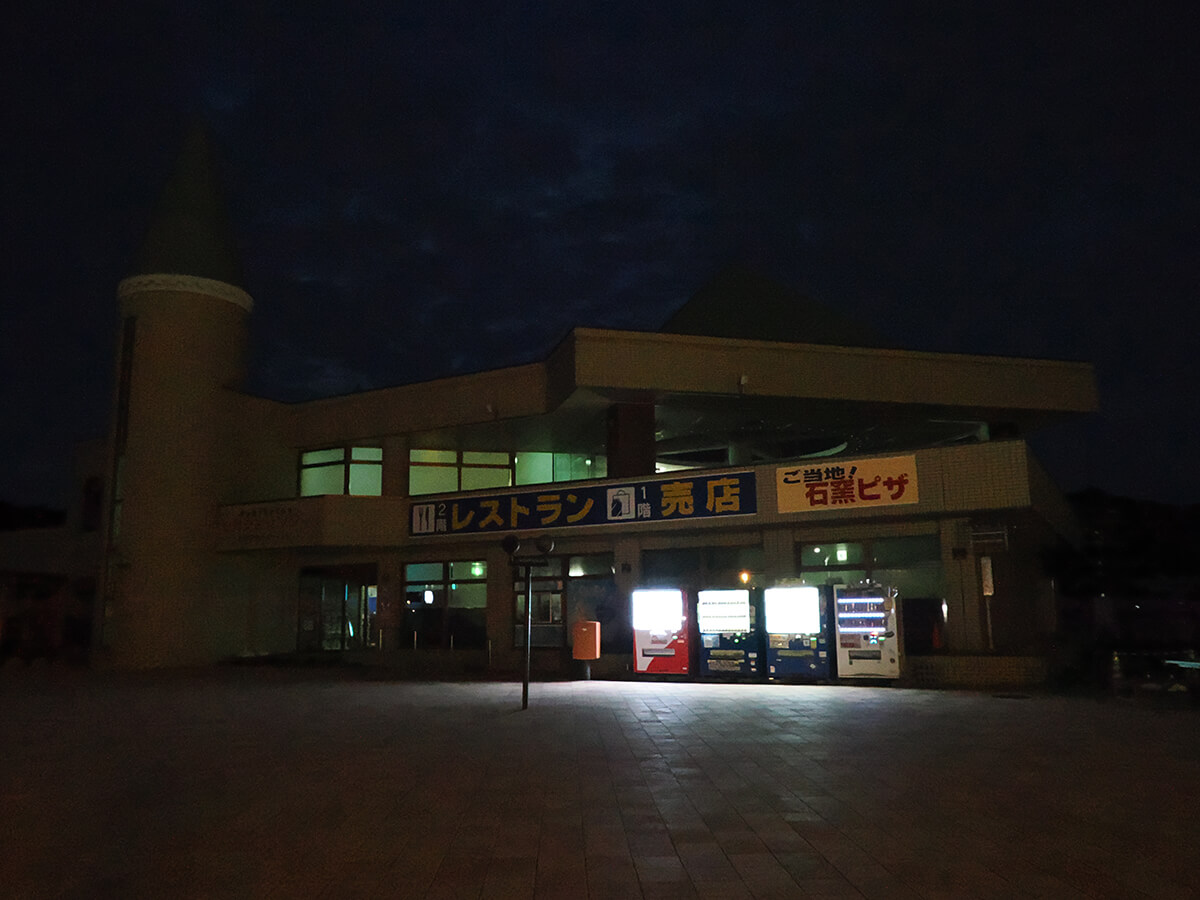
M.ZUIKO DIGITAL ED 12-40mm F2.8 PRO II/OM SYSTEM OM-1 Mark II/Equivalent to 24mm (35mm format equivalent)/Shutter speed priority AE (F2.8, 1/50 seconds)/ISO 25600/Exposure compensation: +0.7EV/WB: Auto/Picture mode: Vivid
Roadside Station Star Plaza Ashibetsu. The roadside station is large, so there is plenty of parking space.
I go to various places in Hokkaido to test my lens articles, filters, and cameras, but I sometimes go on filming trips a few days a year. In winter, the area is mostly eastern Hokkaido, but in 2024, I had planned to photograph the scenery of Furano and Biei this summer, then photograph the sea rabbits on the mountains of the Daisetsu Mountains.
However, this summer, the weather in Hokkaido is surprisingly unstable. Normally, in July or August, it is not uncommon for days to be sunny for three days, but this year, most of the weather forecasts are cloudy, sometimes cloudy, sometimes rainy, and sometimes sunny, sometimes cloudy. Due to my schedule with work, I headed to Furano from my hometown of Chitose City on a day when the weather forecast was relatively likely to be sunny.
On my filming trip, I want to take pictures of the dramatic times of the sun and the sunset, so I'll start going out the night before. You can travel at night and start filming with the dramatic view of the sunrise. This time, I went out on a two-night, three-day schedule, departing from Chitose City, where the airport is located, on a Friday night, and returning to Chitose City on a Sunday night. It will also be useful for those who arrive in New Chitose Airport on Friday nights and then rent a car touring around Hokkaido.
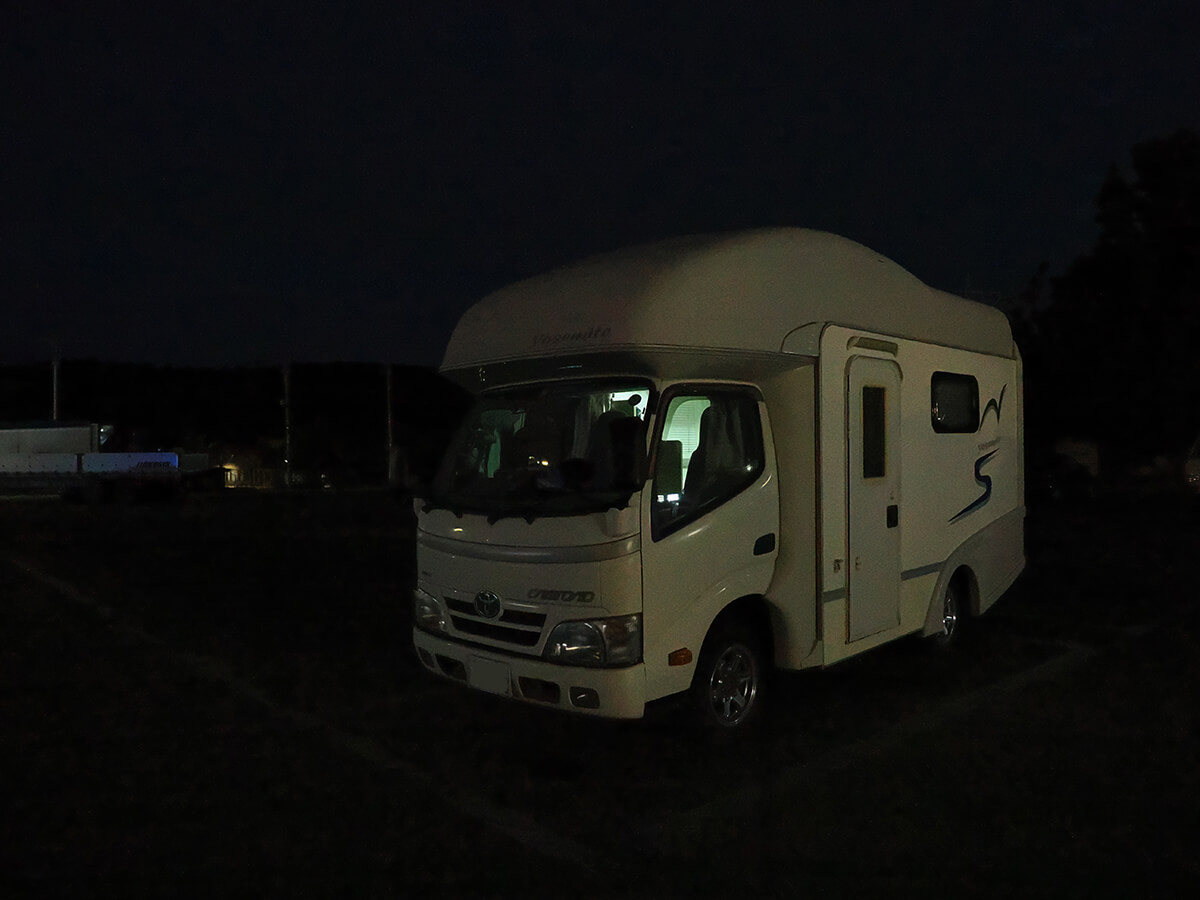
M.ZUIKO DIGITAL ED 12-40mm F2.8 PRO II/OM SYSTEM OM-1 Mark II/Equivalent to 24mm (35mm format equivalent)/Shutter speed priority AE (F2.8, 1/50 seconds)/ISO 25600/Exposure compensation: +0.7EV/WB: Auto/Picture mode: VividIt
's already late July when the metropolitan area has started summer vacation, but there was quite a lot of room in the parking lot at the roadside station Star Plaza Ashibetsu. Thanks to this, I was able to sleep well.
By the way, the plan is to move to the Furano area the night before and take a picture of the sunrise and lavender fields at Hinode Park Lavender Garden in Kamifurano Town. When I was on a photo shoot trip, I used a camper van, so I went on a car trip while sleeping in my car. Therefore, I select nearby road stations where I can take a nap until the sunrise period, but personally I don't recommend the high season road station Biei "Hokkaido Kura." Originally, for a road station in Hokkaido, the facility is small with 21 regular cars and 2 large cars, so the parking lot is often filled and is not suitable for taking a nap. Therefore, after taking a nap at Star Plaza Ashibetsu, a roadside station in the adjacent Ashibetsu city, I moved to Hinode Park Lavender Garden before sunrise.
The parking lot at the roadside station Star Plaza Ashibetsu is quite spacious, with 114 regular cars and 12 large cars, so we recommend it. If you don't have to enter Furano or Biei from the sunrise time, then the roadside station in front of you, Utano Tyrol's Yu is also packed with hot spring facilities, making it my favorite roadside station.
The sunrise in the lavender garden in the sun, the weather forecast is not good
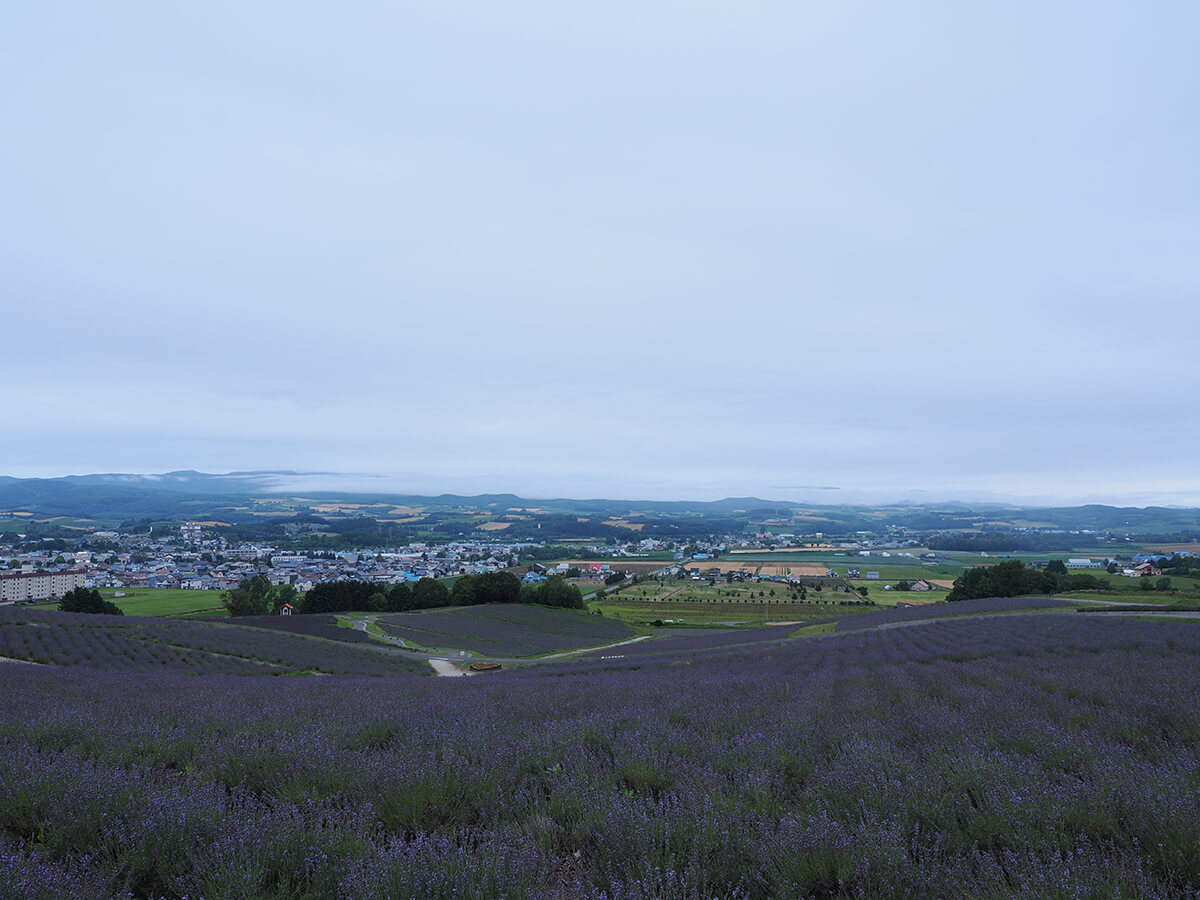
M.ZUIKO DIGITAL ED 12-40mm F2.8 PRO II/OM SYSTEM OM-1 Mark II/Equivalent to 24mm (35mm format equivalent)/Aperture priority AE (F8.0, 1/13 seconds)/ISO 200/Exposure compensation: +0.7EV/WB: Sunny weather/Picture mode:
The beautiful scenery of the Vivid Lavender field, but if it gets cloudy, it won't create an exhilarating summer in Hokkaido.
I arrived at the lavender garden of Hinode Park in Kamifurano Town before sunrise to start taking photos from the scenery of the lavender fields illuminated in the morning sun, but there were no other cars, so in a way it was cloudy as I was worried about. In fact, no matter where the location is, there is no use for example of a photograph of Hokkaido in the summer with cloudy sky.
Disappointingly, even after checking the future weather forecast, it seems that there have been no sunny days in the Furano and Biei areas in the last few days. However, I couldn't give up on the clear sky, so I moved from Furano and Biei to find a place where it was planned to clear up. Hokkaido, which is said to be wider than small European countries, often has different weather conditions depending on the region. As a result, it is forecast that the Sea of Japan side of the north of Hokkaido will be sunny. Although it is a minor route compared to Furano and Biei, the driving route that runs along the Sea of Japan north of Hokkaido is called the Ororon Line. I have also run many times to film, and even Hokkaido residents praise the Ororon Line on clear summer weather, saying, "The Ororon Line driving is the best!"
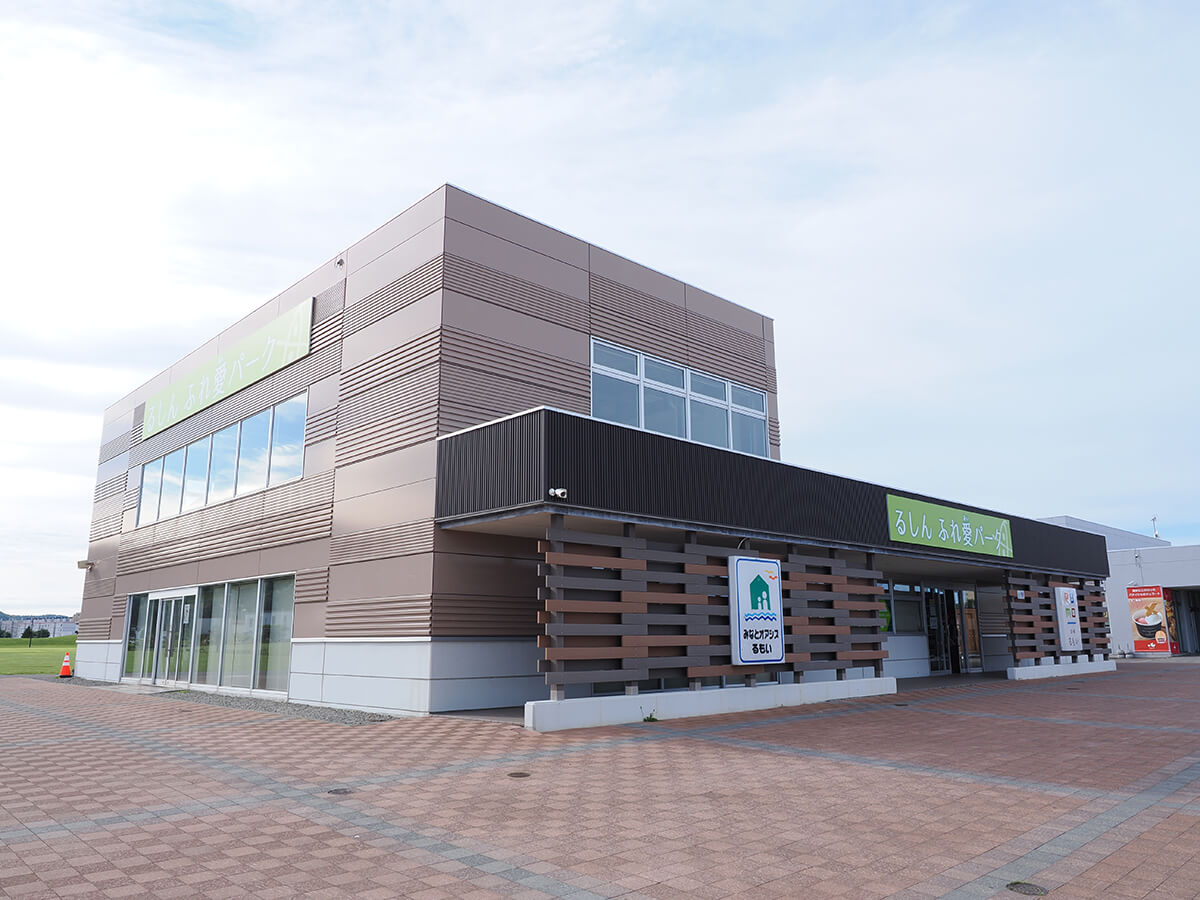
M.ZUIKO DIGITAL ED 12-40mm F2.8 PRO II/OM SYSTEM OM-1 Mark II/Equivalent to 24mm (35mm format equivalent)/Shutter speed priority AE (F10, 1/160sec)/ISO 200/Exposure compensation: +0.3EV/WB: Sunny weather/Picture mode: Rumoi,
the roadside station, the first stop on the Vivid Ororon line. I came to the Ororon Line to escape the cloudy sky, but the sky has not yet been able to escape from the cloudy sky.
In fact, if you go northwest from Furano and Biei, as well as Asahikawa, you can enjoy the Ororon Line, so it depends on the weather, but if the weather is not stable like this year, we recommend that you remember the Ororon Line as an option when the weather is bad in Furano and Biei. This time, we will introduce the Ororon Line journey between the OM SYSTEM "OM-1 Mark II" and the Daisangen lens.
The Ororon Line is a beautiful landscape, with a wide range of roadside stations, hot springs and campsites.
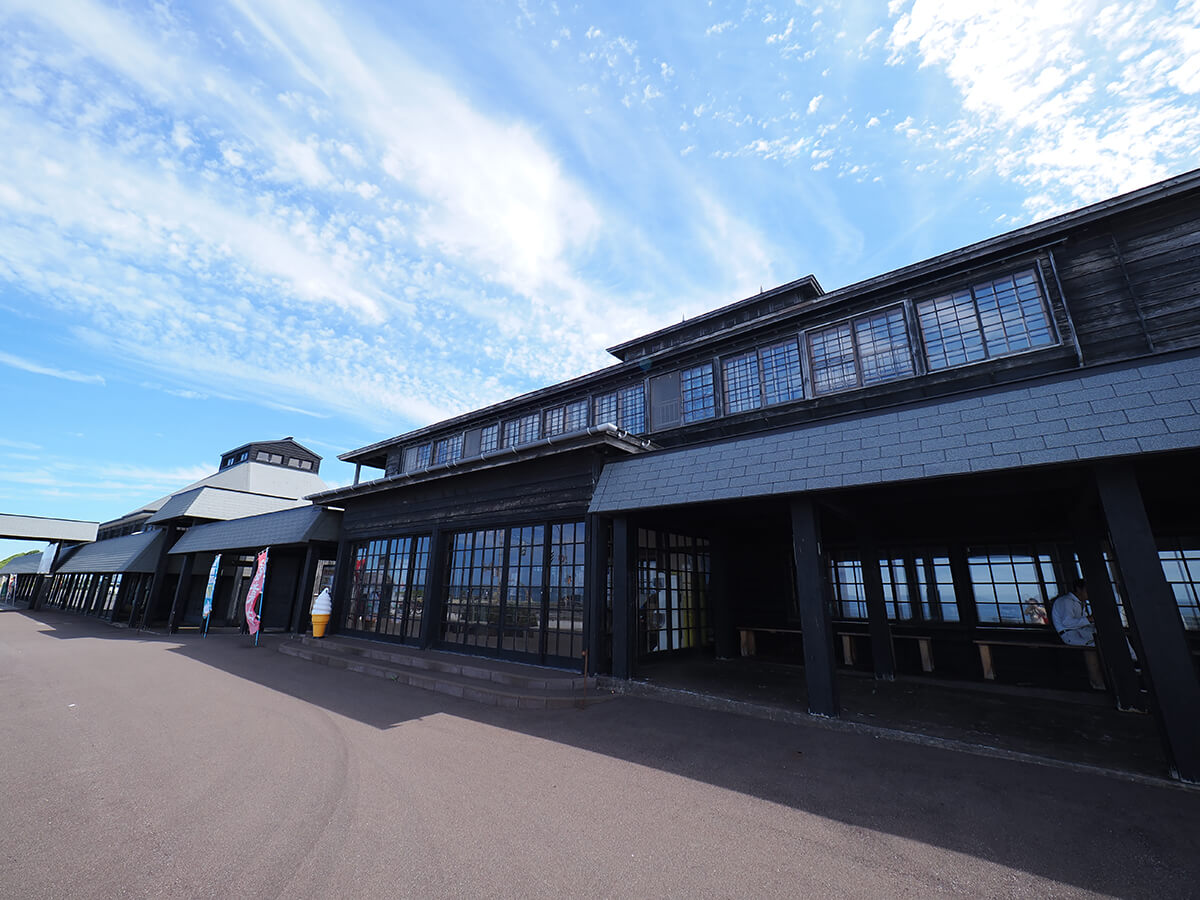
M.ZUIKO DIGITAL ED 7-14mm F2.8 PRO/OM SYSTEM OM-1 Mark II/Equivalent to 14mm (35mm format equivalent)/Aperture priority AE (F3.5, 1/1,000 seconds)/ISO 200/Exposure compensation: +0.3EV/WB: Sunny weather/Picture mode: Vivid
The Ororon Line, which is a large-scale, new roadside station, continues. The photo shows the Obira Herringbangya roadside station in Kodairacho. There is a real herring shop preserved next to you, and you can also visit.
It has a rich range of 10 road stations, about 200km from Rumoi to Cape Soya.
The Ororon Line itself is about 320km from just north of Sapporo, from Otaru and Ishikari to Cape Soya, the northernmost tip of Wakkanai and Hokkaido's main island, but Rumoi will start if you head northwest from Asahikawa, Furano or Biei.
If you head north from Rumoi, you will pass through 10 cities and towns: Kodaira, Tomamae, Haboro, Haboro, Hassanbetsu, Enbetsu, Tenshio, Horonobe, Furukawa, and Wakkanai, but it is a roadside station that is slightly off the route. If you don't know, there are 24-hour toilets and free parking, but there are eight roadside stations beside Cape Soya, which is not a roadside station.
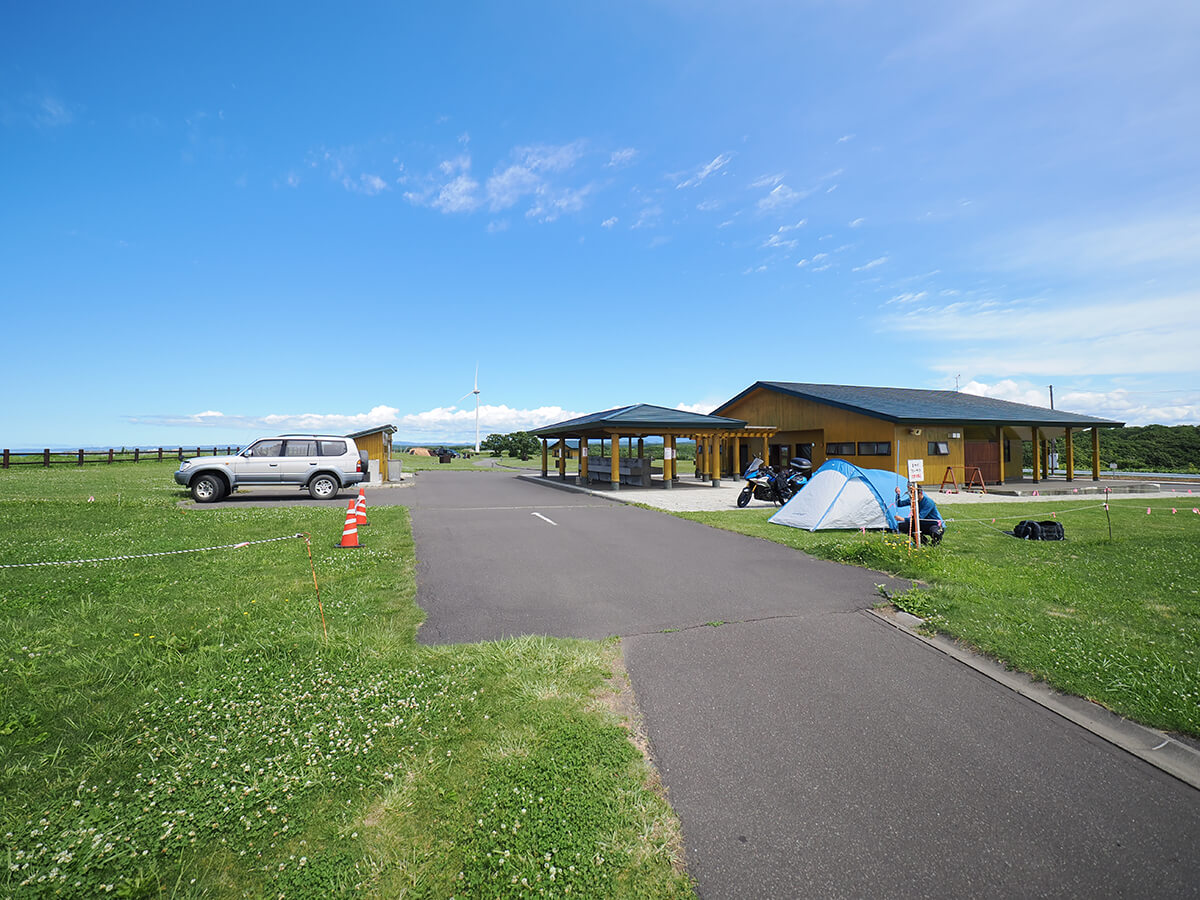
M.ZUIKO DIGITAL ED 7-14mm F2.8 PRO/OM SYSTEM OM-1 Mark II/Equivalent to 14mm (35mm format equivalent)/Aperture priority AE (F2.8, 1/2,500 seconds)/ISO 200/Exposure compensation: +0.7EV/WB: Sunny weather/Picture mode: Vivid
Photos at Tomamae Yuhigaoka Auto Campground. Although it also has the effect of an ultra-wide-angle lens equivalent to 14mm, there are many spacious campsites on the Ororon Line.
The distance between Rumoi and Soya Cape is approximately 200km, so the fact that there are toilets, parking and rest areas equivalent to one road station every 20km is quite comprehensive for a drive course in Hokkaido. Therefore, there is almost no need to worry about nap spaces or toilets when sleeping in the car.
Another feature is that there are hot springs where you can take day trips at a pace that can be taken at each city or town, as well as a wide range of campsites. The campsites are generally in the summer season. Most of the time is closed in winter. There are also quite a few beaches during the summer season, so it's a good idea to enjoy the short summer seas of Hokkaido.
Must-see points for Ororon Line
Tomamae's "Sankebetsu Bear Incident Restoration Site" - seven people died, and the site of the worst animal damage incident in Japanese history
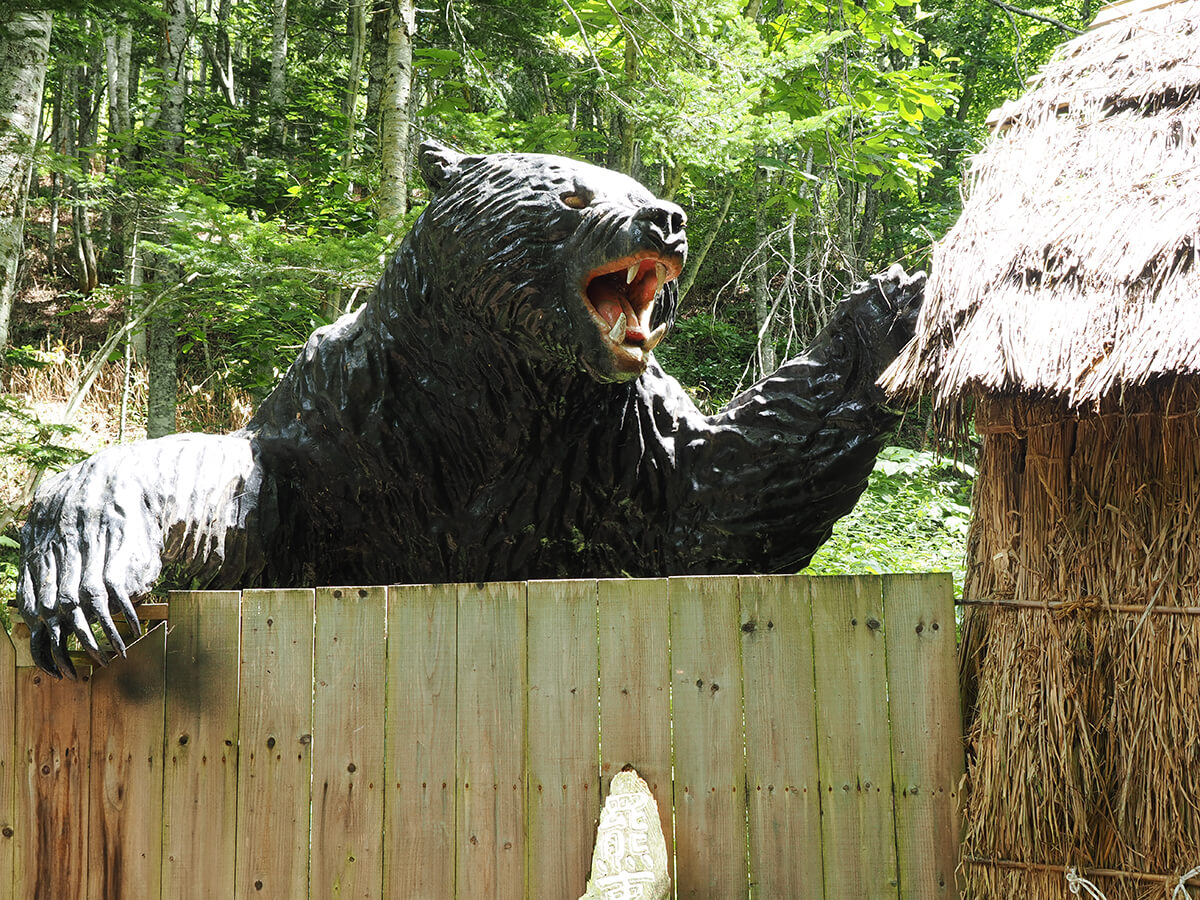
M.ZUIKO DIGITAL ED 12-40mm F2.8 PRO II/OM SYSTEM OM-1 Mark II/Equivalent to 38mm (35mm format equivalent)/Aperture priority AE (F5.6, 1/30sec)/ISO 200/WB: Sunny weather/Picture mode:
In the Vivid Sankebetsu Bear Incident, a brown bear with a body length of 2.7m and weighing 340kg attacked the village, so the restored brown bear in the photo may not be overstated.
Here are some points that I recommend stopping by when I run along the Ororon Line. The first place is the "Sankebetsu Bear Incident Restoration Site" in Tomamae Town. Many of you may know from Yoshimura Akira's documentary, Bear Arashi, that occurred in 1915, the worst animal damage incident in Japanese history, caused a tragic disaster, with seven people, including a fetus dragged away by a brown bear, and three people injured.
Although it has already been more than 100 years, this tragic incident has not faded away, and according to Tomamae Town's website, "it was restored with the strong enthusiasm of Sankei district residents to pass on the indomitable pioneering spirit and the feats of their ancestors through tragic stories of the development, and the "restoration site of Sankei district residents" is a site that has not been transformed into a tragic event. The opening period is from May 1st to the end of October, and there is no opening time, but brown bears may appear on site, so it is dangerous to visit at night, so it is a warning to stop.
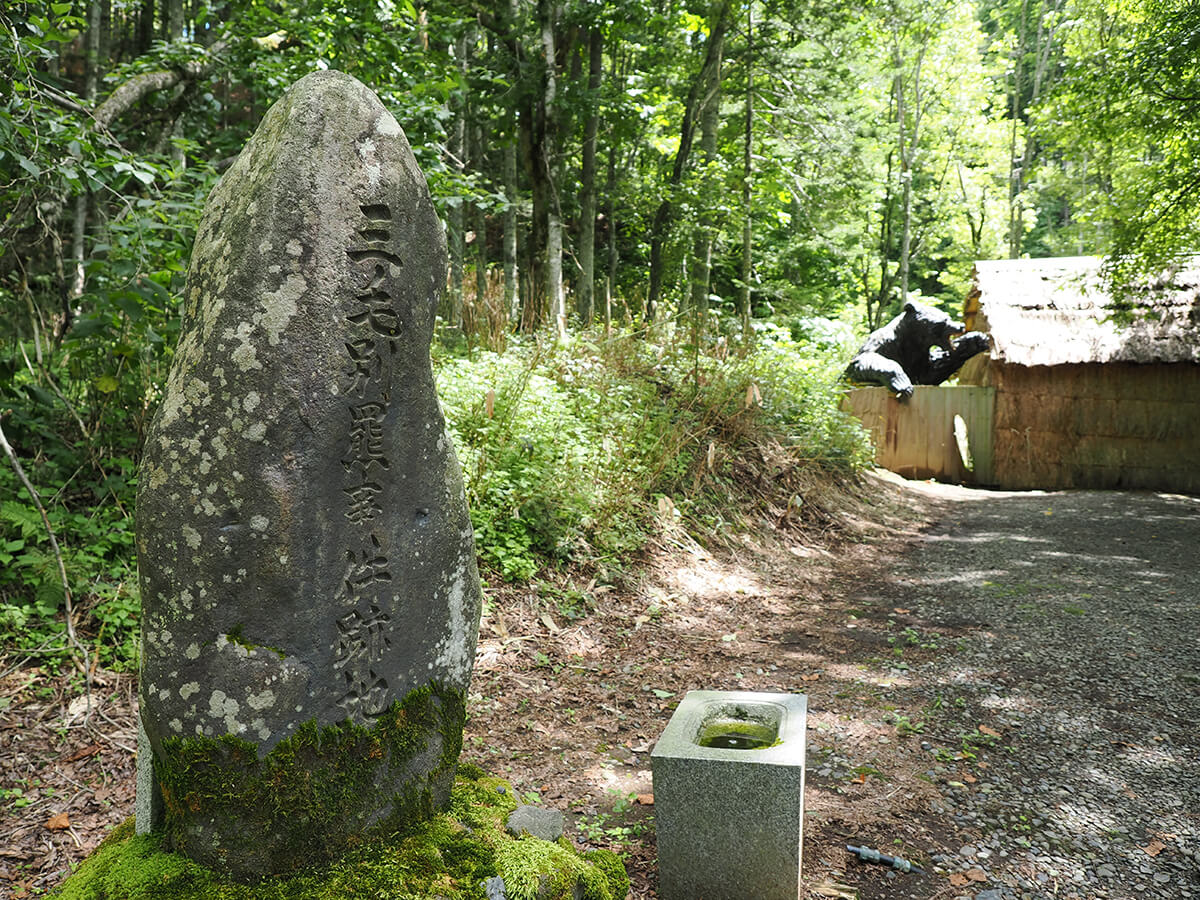
M.ZUIKO DIGITAL ED 12-40mm F2.8 PRO II/OM SYSTEM OM-1 Mark II/Equivalent to 24mm (35mm format equivalent)/Aperture priority AE (F2.8, 1/200 seconds)/ISO 200/WB: Sunny weather/Picture mode:
A stone monument engraved with "Sankebetsu Bear Incident Site" Every time I visit this place, I feel the scary nature of nature. Be sure to visit once.
I have visited the site several times, but the roads have disappeared and no mobile phone signal is available, and for some reason the Sankebetsu Bear Incident Restoration Site has a lot of bees, making it an indescribable spot that makes you feel terrifying. And every time I come to realize that there is a danger as another face to Hokkaido's majestic nature.
Hatsuyamabetsu Konpira Shrine is a beautiful torii gate that is perfect for daytime, sunset, and star times.
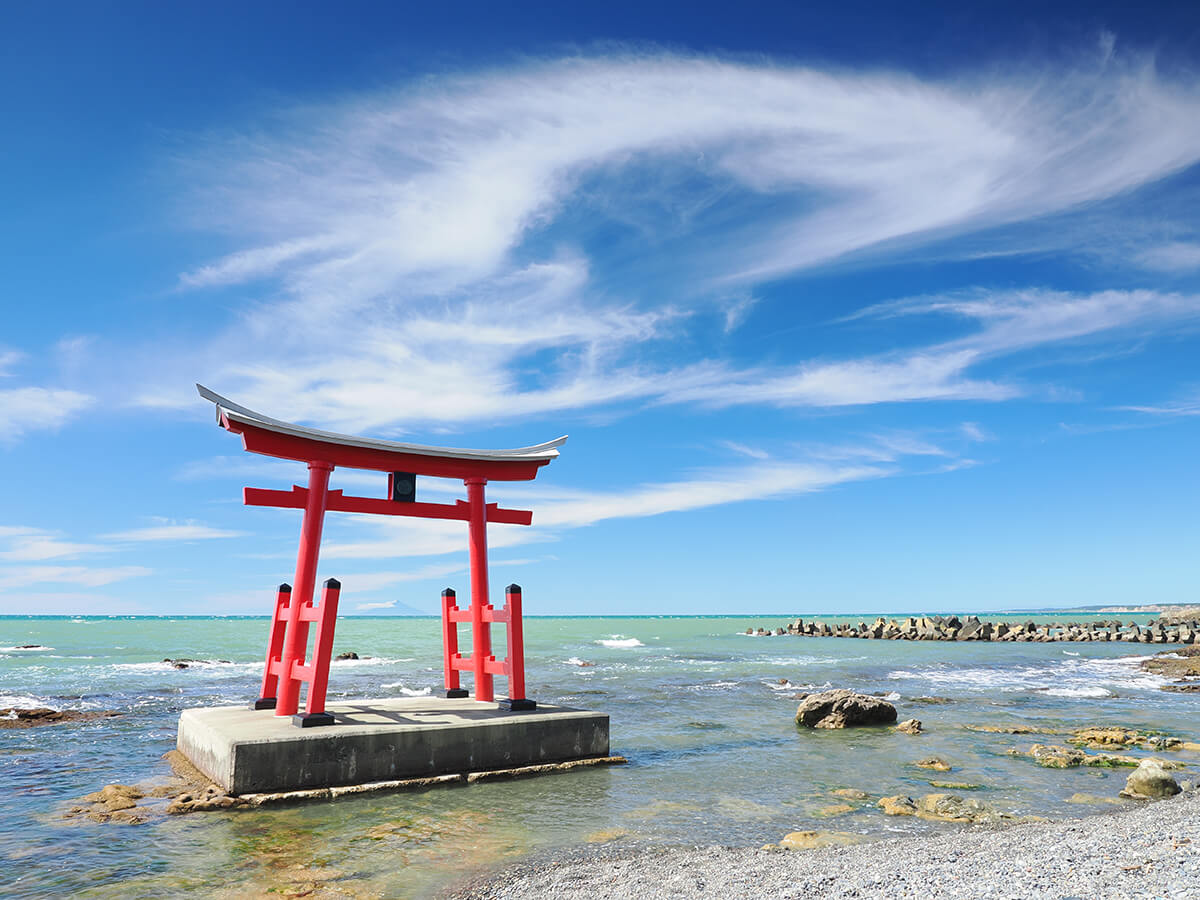
M.ZUIKO DIGITAL ED 12-40mm F2.8 PRO II/OM SYSTEM OM-1 Mark II/Equivalent to 24mm (35mm format equivalent)/Aperture priority AE (F8.0, 1/60sec)/ISO 200/Exposure compensation: +1.0EV/WB: Sunny weather/Picture mode: Vivid/GND+PL filter
Cloudy The pleasant blue sky that is typical of Hokkaido that makes you feel happy that you escaped from the sky also highlights the ease of the M.ZUIKO DIGITAL ED 12-40mm F2.8 PRO II.
The Ororon Line has beautiful scenery, but one of the photo spots on the Ororon Line that you will definitely stop by if you like photography is the underwater torii gate at Konpira Shrine in Hatsuyamabetsu Village. The photos posted this time are taken of the daytime events.
The underwater torii gate at Konpira Shrine is a picturesque sight even in the daytime, as long as the weather is good, but since it is located on a west-facing coast, naturally, even during the sunset, there is an even more dramatic view. If you visit at sunset, you may find many photographers lined up.
There are also roadside stations such as the Roman Kaido Shosanbetsu, the hot spring facility Misaki no Yu, the Shosanbetsu Observatory Deck, Konpira Lighthouse, campsite, and go-kart courses, so if you stay in each Hatsuyama area, you can also enjoy the underwater torii gates of Konpira Shrine, which is set in the middle of the sea, with noon, sunset, and starry sky in the background. The starry sky is also beautiful and beautiful, making it a recommended point for starry photographs.
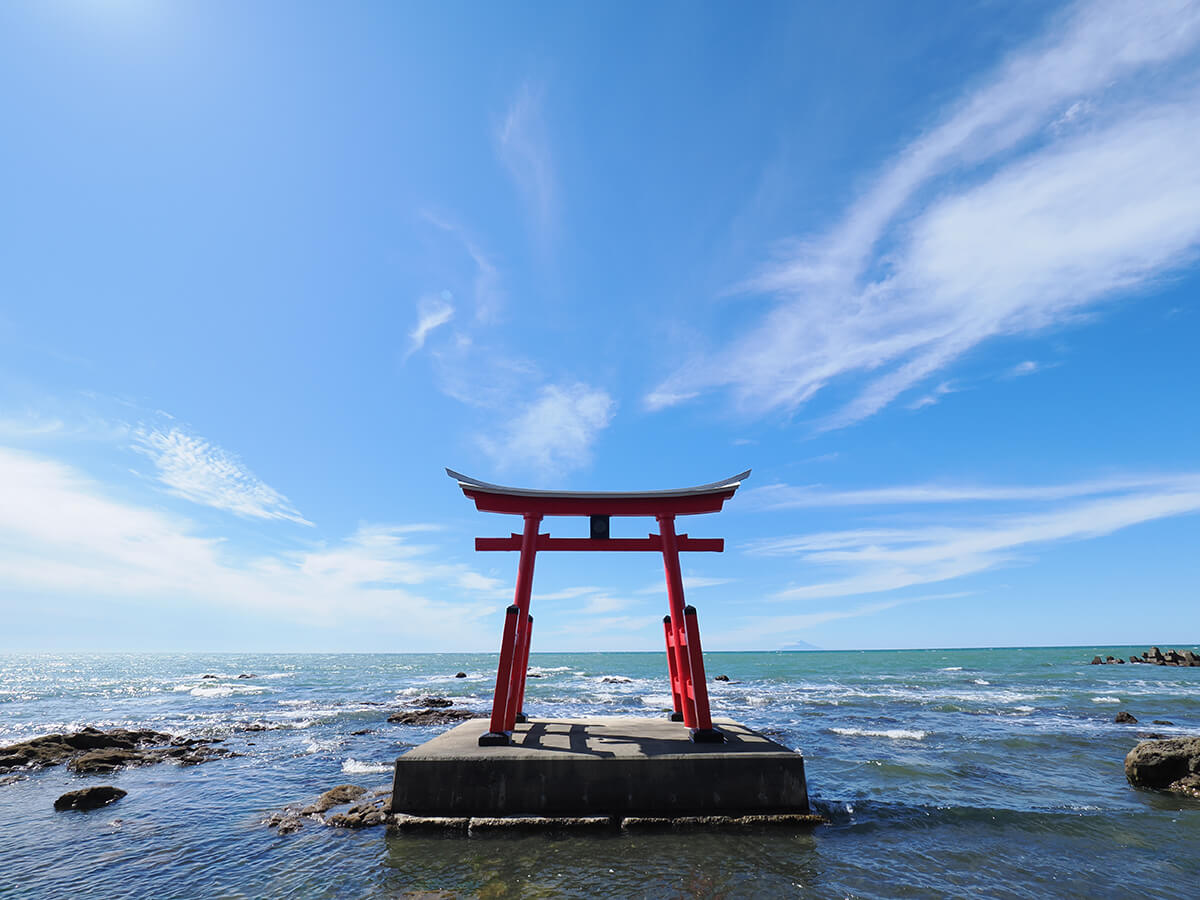
M.ZUIKO DIGITAL ED 7-14mm F2.8 PRO/OM SYSTEM OM-1 Mark II/Equivalent to 14mm (35mm format equivalent)/Aperture priority AE (F8.0, 1/400 seconds)/ISO 200/Exposure compensation: +1.0EV/WB: Sunny weather/Picture mode:
Different angles taken with the M.ZUIKO DIGITAL ED 7-14mm F2.8 PRO with vivid wide-angle zoom. You can take photos with a variety of expressions depending on the angle, lens, and time of day.
Wakkanai "Souya Cape" Cape at the northernmost tip of the main island of Hokkaido
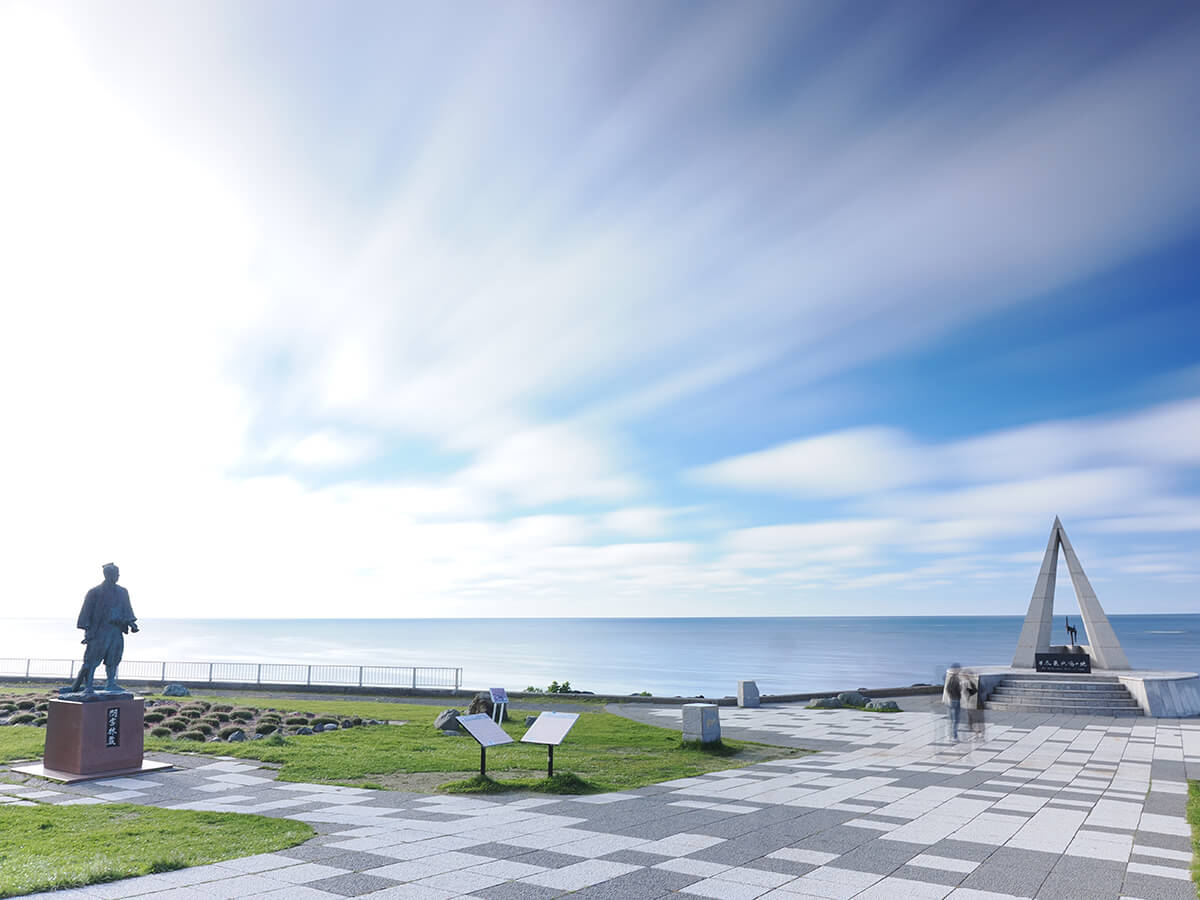
M.ZUIKO DIGITAL ED 12-40mm F2.8 PRO II/OM SYSTEM OM-1 Mark II/Equivalent to 24mm (35mm format equivalent)/Aperture priority AE (F9.0, 30 seconds)/ISO 200/WB: Sunny weather/Picture mode: Vivid/ND filter
Considering the use of this product in web articles, it is better not to see people in the picture, so the ND filter slows the shutter speed and hangs out.
Cape Soya, the northernmost tip of Hokkaido's main island, is a must-see spot if you've made it to Wakkanai. Of course, it is also an event that you should never forget to take commemorative photos at Cape Soya, the northernmost point of Japan.
I have visited the site many times, and no matter how many times I visit, I am quite impressed that this is the northernmost point of Japan. In the summer, tourists are constantly coming, including tourist buses, so there may be a line in front of the monuments to take commemorative photos. I take photos as photostock, so I use long exposures using an ND filter to prevent other people from appearing as much as possible.
Also, one of the author's goals to reach Cape Soya is to take a picture of the adjacent Soya Hills, with windmills lined with white roads, and if possible, I would like to take a picture of the starry scenery here. However, this time the weather also fell out from the evening, and we were unable to photograph the scenery we had hoped for.
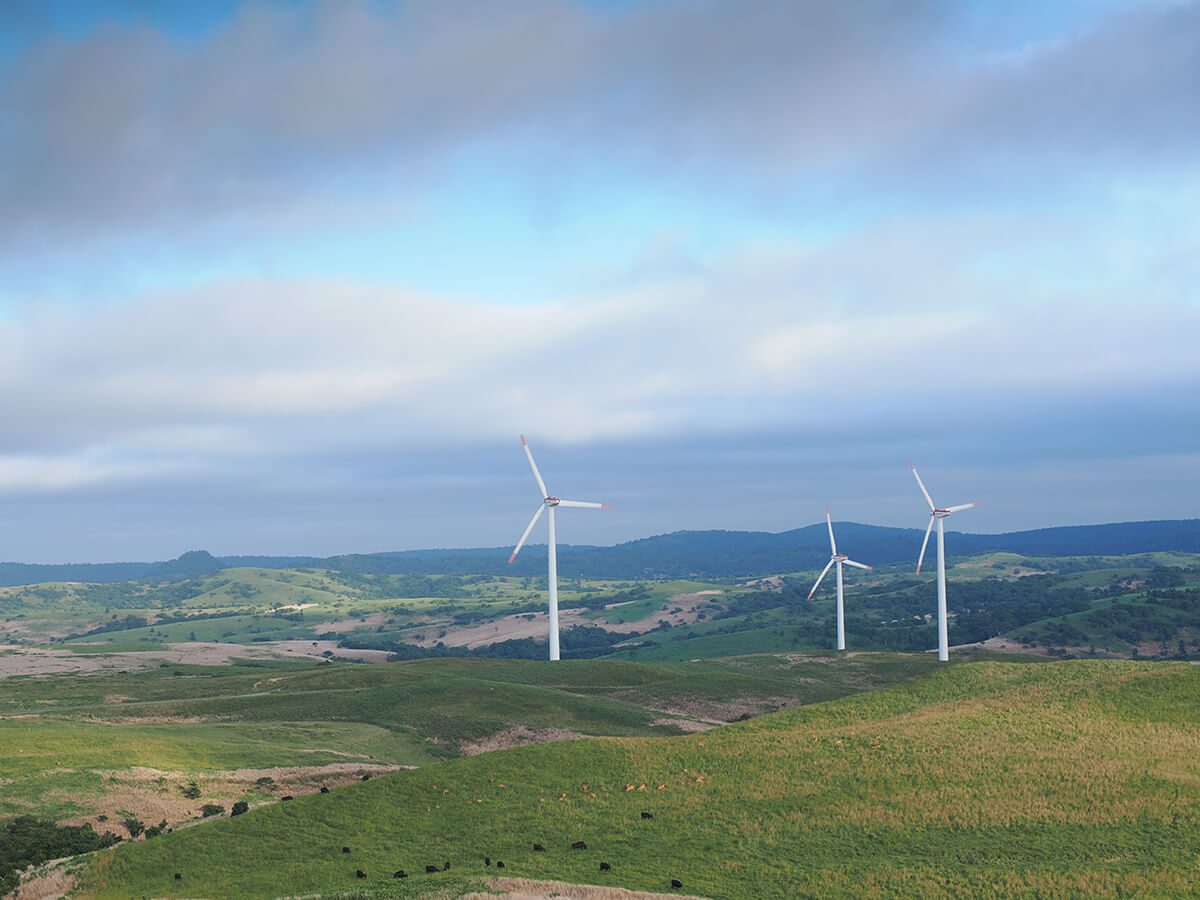
M.ZUIKO DIGITAL ED 12-40mm F2.8 PRO II/OM SYSTEM OM-1 Mark II/Equivalent to 24mm (35mm format equivalent)/Aperture priority AE (F8.0, 1/50sec)/ISO 200/Exposure compensation: +1.0EV/WB: Sunny weather/Picture mode: Vivid
Can you see that the clouds at high places in the sky are black? It is clear that the impression of the scenery is quite dependent on the weather.
I like the fantastic atmosphere of the night view of Wakkanai's "North Breakwater Dome"
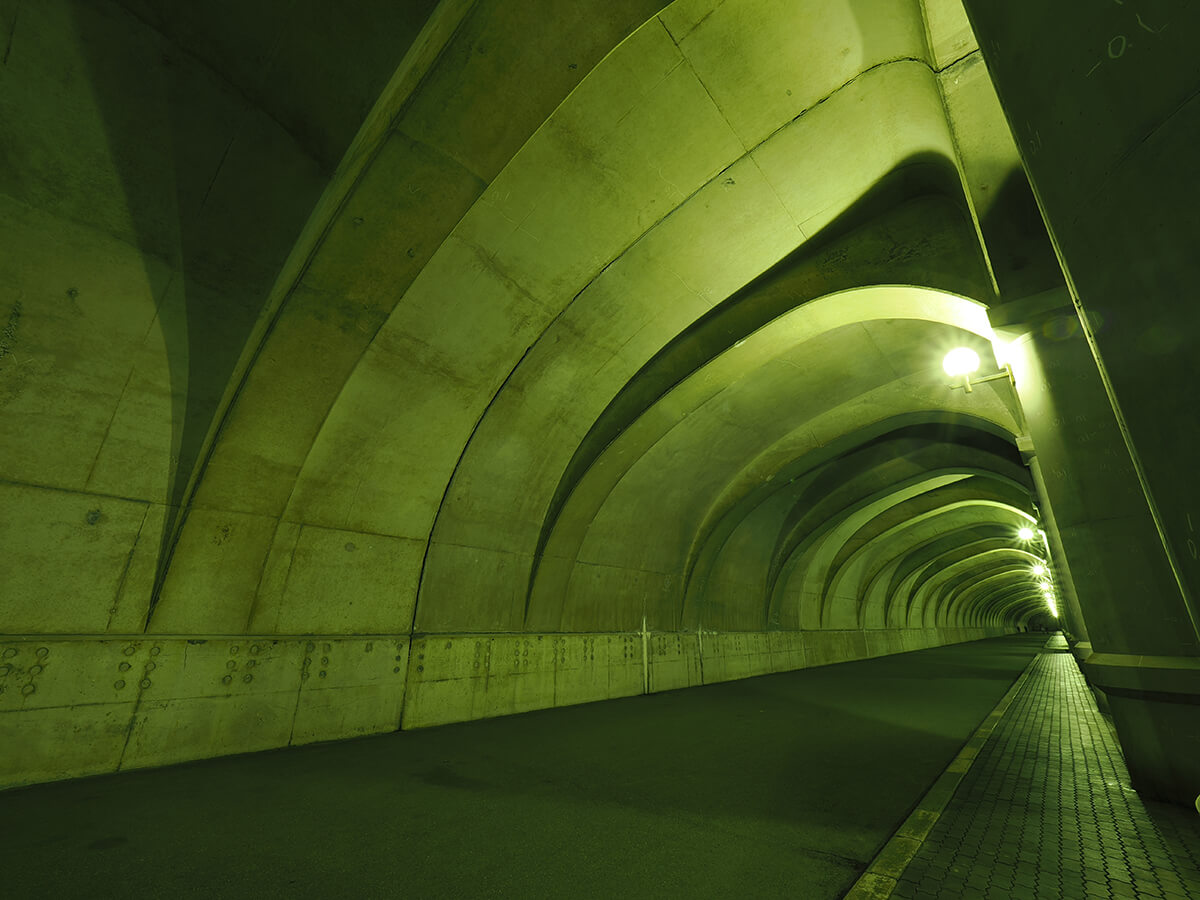
M.ZUIKO DIGITAL ED 7-14mm F2.8 PRO/OM SYSTEM OM-1 Mark II/Equivalent to 14mm (35mm format equivalent)/Aperture priority AE (F8.0, 2.5 seconds)/ISO 200/Exposure compensation: -0.3EV/WB: Sunny weather/Picture mode: Vivid M.ZUIKO DIGITAL ED 7-14mm F2.8 PRO's ultra-wide angle equivalent to 14mm I tried taking a picture with the image of depth. I think it was finished in a way that lasts forever.
When I arrive in Wakkanai City, I always take a picture of the North Breakwater Dome in the evening. This breakwater was built between 1931 and 1936, and is a beautiful building with thick columns reminiscent of ancient Roman architecture and corridors with gentle curves.
The designer was Tsuchiya Minoru, 26 years old at the time, and was an engineer at the Hokkaido Agency, who had only graduated from Hokkaido University for three years. When Wakkanai North Pier was used as a departure and arrival spot for the former Sakhalin route, it was built to prevent strong winds blowing throughout the four seasons and to prevent waves from splashing onto the railways and roads leading to this location.
The current "North Breakwater Dome" is after three years of renovations since 1978. It was designated as a Hokkaido Heritage Site in 2001. I like to take pictures of this "North Breakwater Dome" in the night view. This photo spot allows you to take pictures with a fantastic atmosphere, with a total of 70 pillars and a unique landscape of 427m in length.
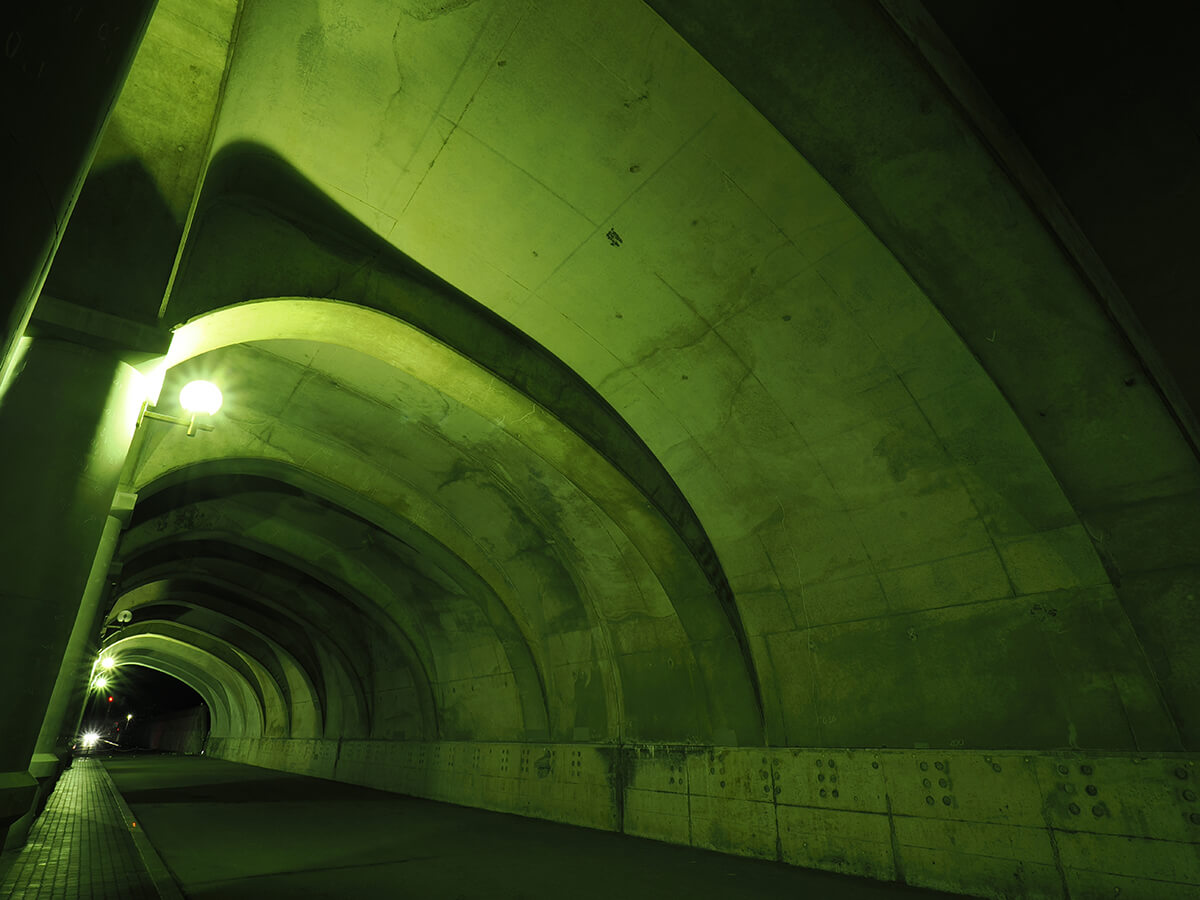
M.ZUIKO DIGITAL ED 7-14mm F2.8 PRO/OM SYSTEM OM-1 Mark II/Equivalent to 18mm (35mm format equivalent)/Aperture priority AE (F8.0, 3.2 seconds)/ISO 200/Exposure compensation: -0.3EV/WB: Sunny weather/Picture mode: Vivid I
put it on the opposite side and deliberately finished it with an outlet. It can be said that you prefer which one is better. It is recommended to take both photos.
Enjoy both the sunset and sunrise at Wakkanai Cape Soya
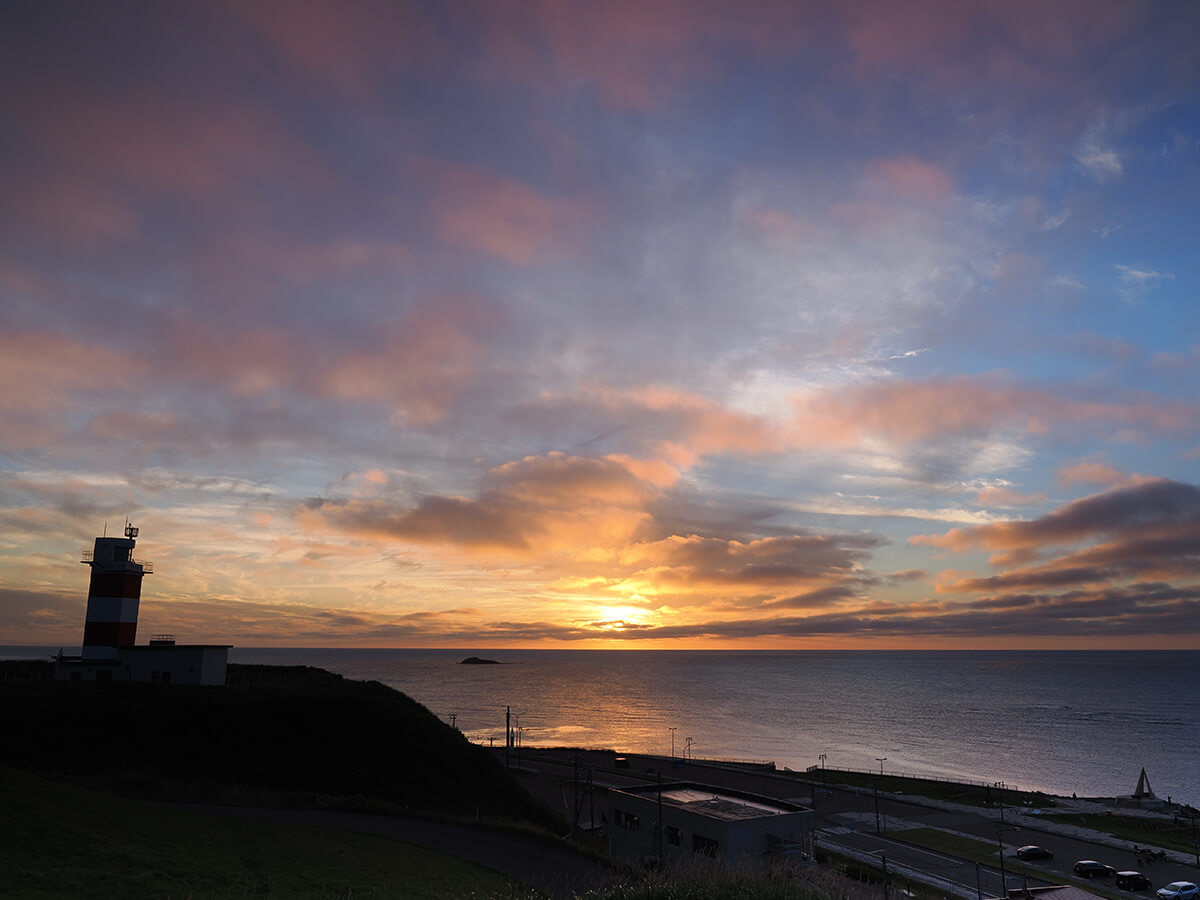
M.ZUIKO DIGITAL ED 12-40mm F2.8 PRO II/OM SYSTEM OM-1 Mark II/Equivalent to 24mm (35mm format equivalent)/Aperture priority AE (F8.0, 1/10 seconds)/ISO 200/Exposure compensation: +0.3EV/WB: Sunny weather/Picture mode: Vivid/GND filter
The sunset over Cape Soya, the northernmost tip of the main island of Hokkaido. That alone makes it a moving and memorable landscape. Since I'm going to try to get to Asahi, I'll try to get to the same Soya Cape.
When I arrive at Cape Soya, which is the finish line of the Ororon Line, I usually take a picture of the sunset there, try taking a starscape photograph on the Soya Hills, then take a picture of the "North Breakwater Dome" in Wakkanai city, then take a nap at the roadside station, and the next morning I often take a picture of the sunrise from around Wakkanai Port or Cape Nosamufu.
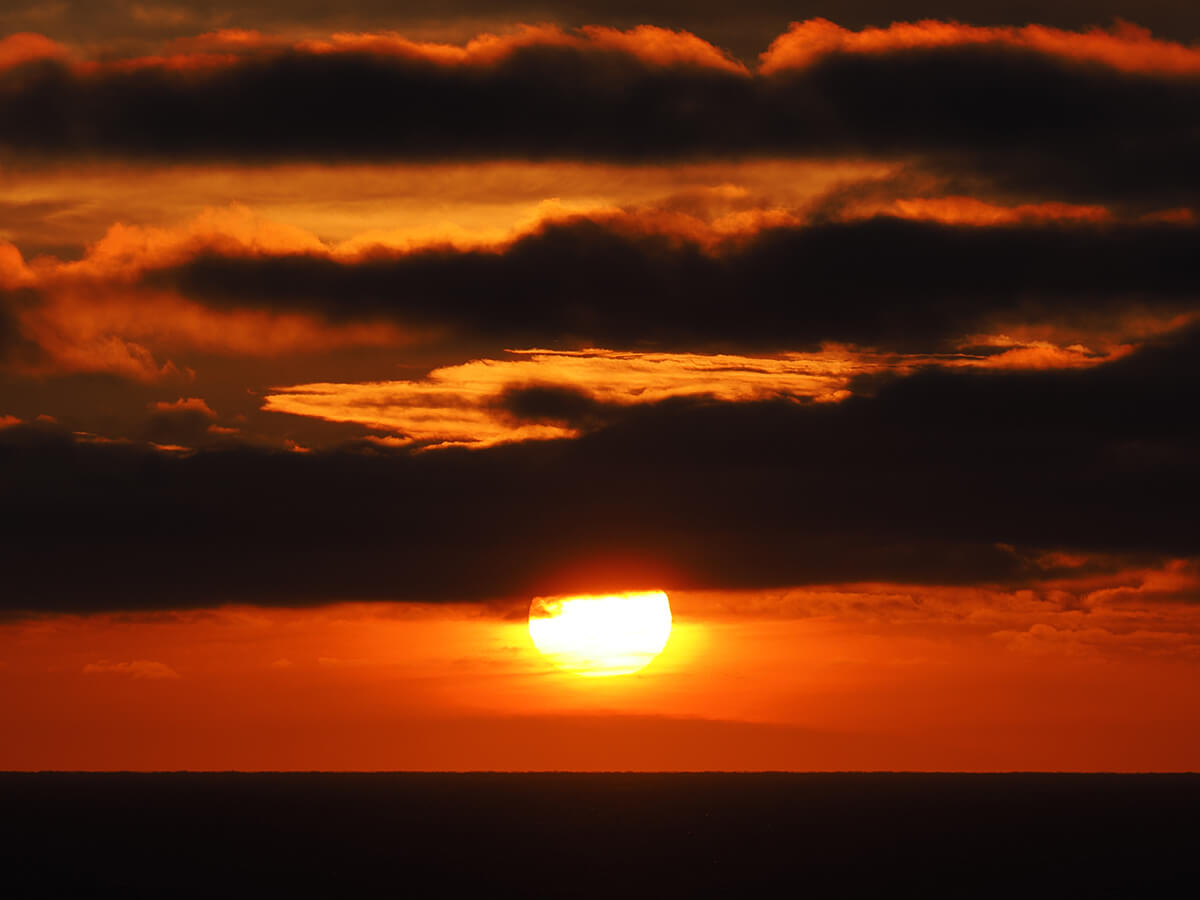
M.ZUIKO DIGITAL ED 40-150mm F2.8 PRO + M.ZUIKO DIGITAL 2x Teleconverter MC-20/OM SYSTEM OM-1 Mark II/Equivalent to 441mm (35mm format equivalent)/Aperture priority AE (F8.0, 1/400 seconds)/ISO 200/Exposure compensation: -1.0EV/WB: Sunny weather/Picture mode: Vivid
Where is it? I don't take many photos as I don't understand the situation, but it's also nice that if I had a super telephoto, I can enjoy such a powerful photograph of the sunset.
However, this time, we took advantage of the advantage of being the northernmost cape in Hokkaido's main island, and set out on a plan to photograph the sunrise at Cape Soya, where we photographed the evening views. After taking pictures of the evening views, I tried taking a starry photograph on the Soya Hills and took a picture of the "North Breakwater Dome" at Wakkanai Port, so I haven't been at Soya Cape for a long time...
Incidentally, the sunrise in July and August is from 3am to 4am, so there is very little time to take a nap. Therefore, after all filming was completed, I took a nap for a few hours at Cape Soya, which has a toilet, and then took a photo of the Asahi.
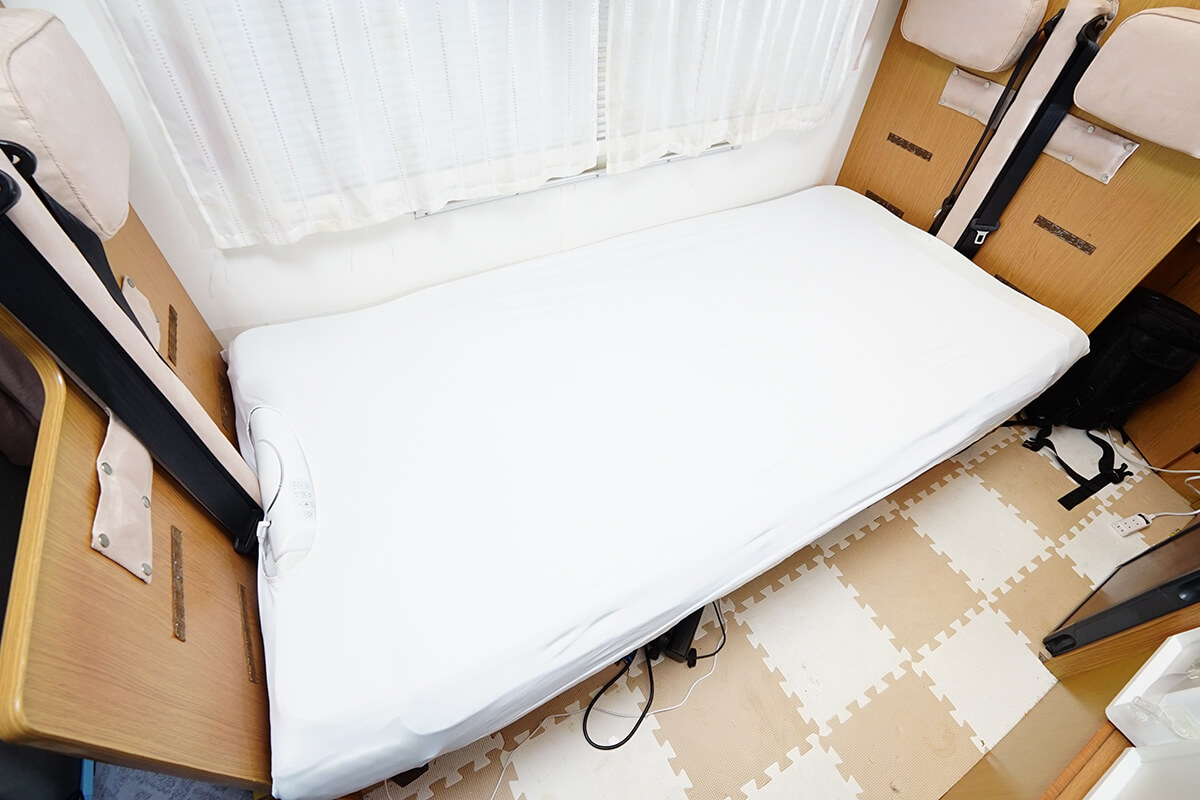
ATEX's "Good Sleep Mat SOYO Single AX-BS632" + dedicated contact cooling box sheet consumes very little power, and is an electric fan that prevents moisture from building up in the bedding, making it very comfortable.
Even though it's Hokkaido, it's been very hot these days, so I'm sleeping through the heat by adding a separate contact cool box sheet to the ATEX's "Good Sleep Mat SOYO Single AX-BS632," which I also introduced in an article on OUTDOOR GEARZINE, to the separately sold special contact cool box sheet. We would appreciate it if you could read more in a separate article, but it's very comfortable just because there's no moisture build up in the bedding. I slept very soundly, but the weather was not good the next day, so it was a shame that the weather had not been good and it was unstable.
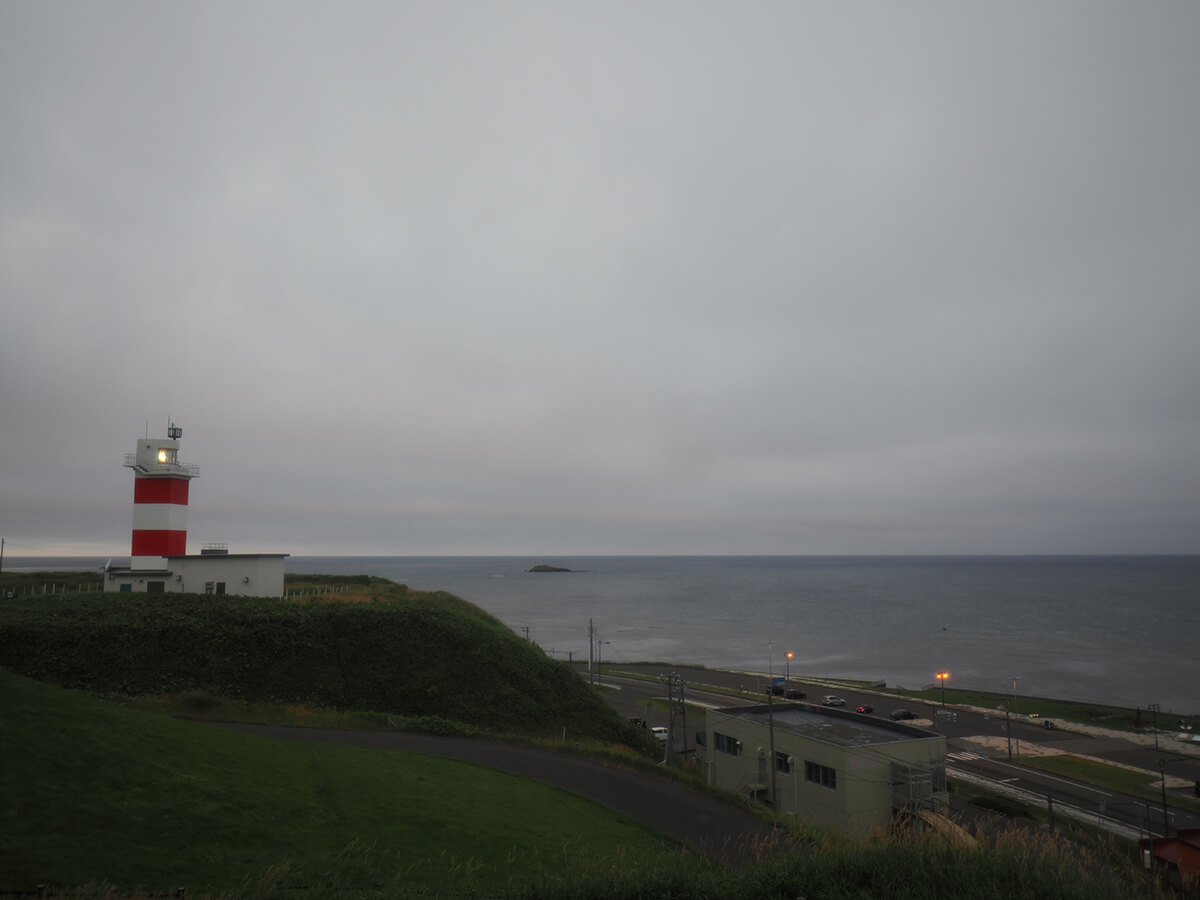
M.ZUIKO DIGITAL ED 7-14mm F2.8 PRO/OM SYSTEM OM-1 Mark II/Equivalent to 28mm (35mm format equivalent)/Aperture priority AE (F2.8, 1/100 seconds)/ISO 200/Exposure compensation: +0.3EV/WB: Auto/Picture mode: Vivid
Soya Misaki is in the Asahi period the next day. These are photos of weather that would not normally be posted. No matter how hard you try, you won't be able to meet the weather.
I also visited "Temaijima", a remote island in Hokkaido and is said to be a paradise for wild birds.
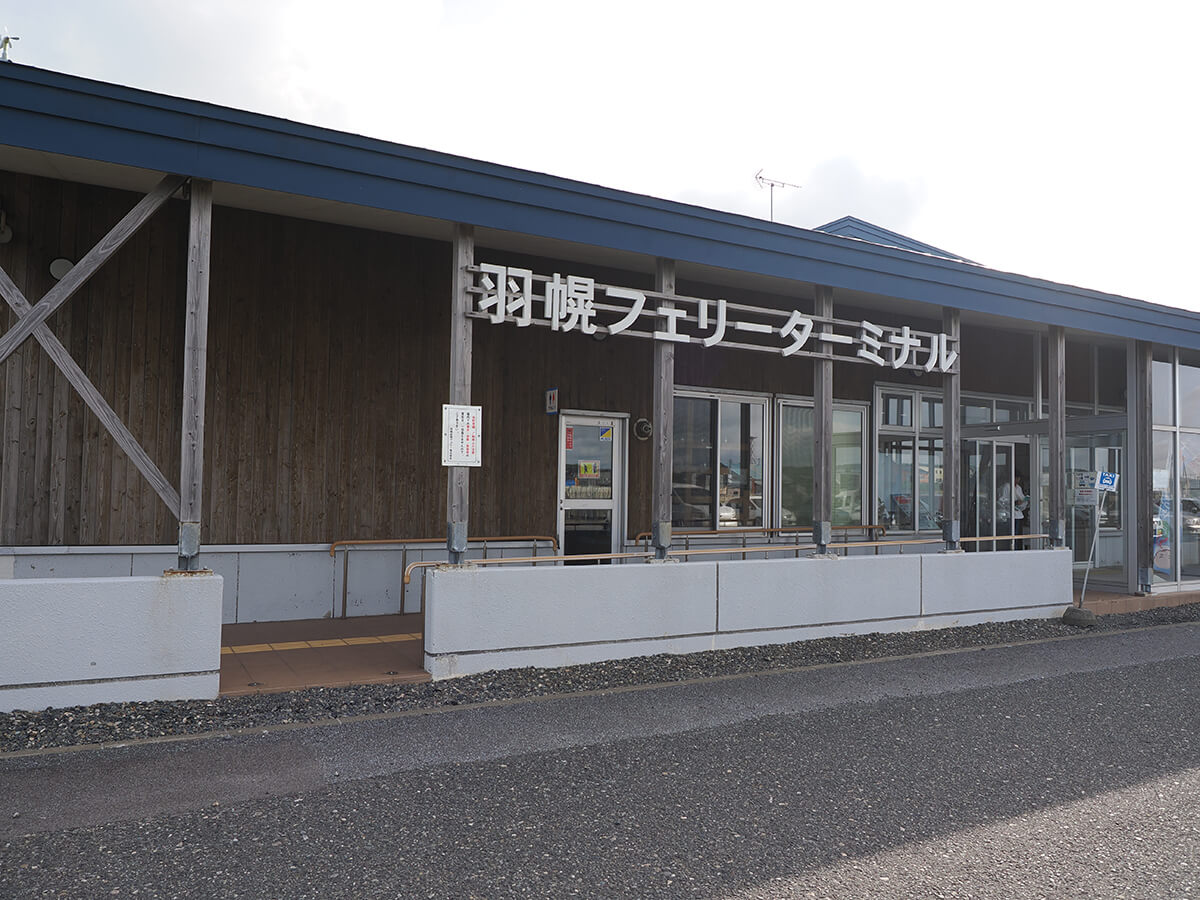
M.ZUIKO DIGITAL ED 12-40mm F2.8 PRO II/OM SYSTEM OM-1 Mark II/Equivalent to 24mm (35mm format equivalent)/Aperture priority AE (F4.0, 1/1,000 seconds)/ISO 200/WB: Auto/Picture Mode:
The Haboro Ferry Terminal, where high-speed boats and ferries to Vivid Temishima and Yakishirishima depart. I visited early in the morning to take the first flight.
I went to Tenmijima, a remote island in Hokkaido, a paradise for wild birds.
It takes about 6-7 hours to stop from Otaru and Ishikari to Wakkanai and Cape Soya. Even if you take a break at a roadside station, you can run for around 10 hours. The drive during this period is filled with the vacant roads and beautiful scenery, and is at what even Hokkaido residents call it one of the best in Hokkaido. I hope you will experience it.
However, I have been running this Ororon Line quite a few times, and this time I'm aiming for a photo shoot. I was planning to photograph the scenery in Furano and Biei and photograph the Naki rabbits in the Daisetsu Mountains. The scenery of the Ororon Line, which runs along the Sea of Japan, was also beautiful enough, and shooting with wide angle and standard zoom was a decent result.
However, ultra-telephoto shooting was not sufficient when installing the "M.ZUIKO DIGITAL ED 40-150mm F2.8 PRO" with the double teleconverter "M.ZUIKO DIGITAL 2x Teleconverter MC-20." One of the major features of the OM-1 Mark II, photographing birds and animals using AI subject recognition AF is so fun that I forget about time, and I was also looking forward to hiking in the Daisetsu Mountains.
In the midst of this, we made a visit to Teurito, a remote island in Hokkaido. Tenmi Island, located 30km off the coast of Haboro Town, floating in the Sea of Japan, is an island that birdwatchers all over the world admire, with a population of about 250 people and a breeding ground of 8 species of seabirds. It is said that walking around is possible, with a circumference of 12km.
A second-class ferry can take you to a remote island from Haboro for around 2,500 yen each way.
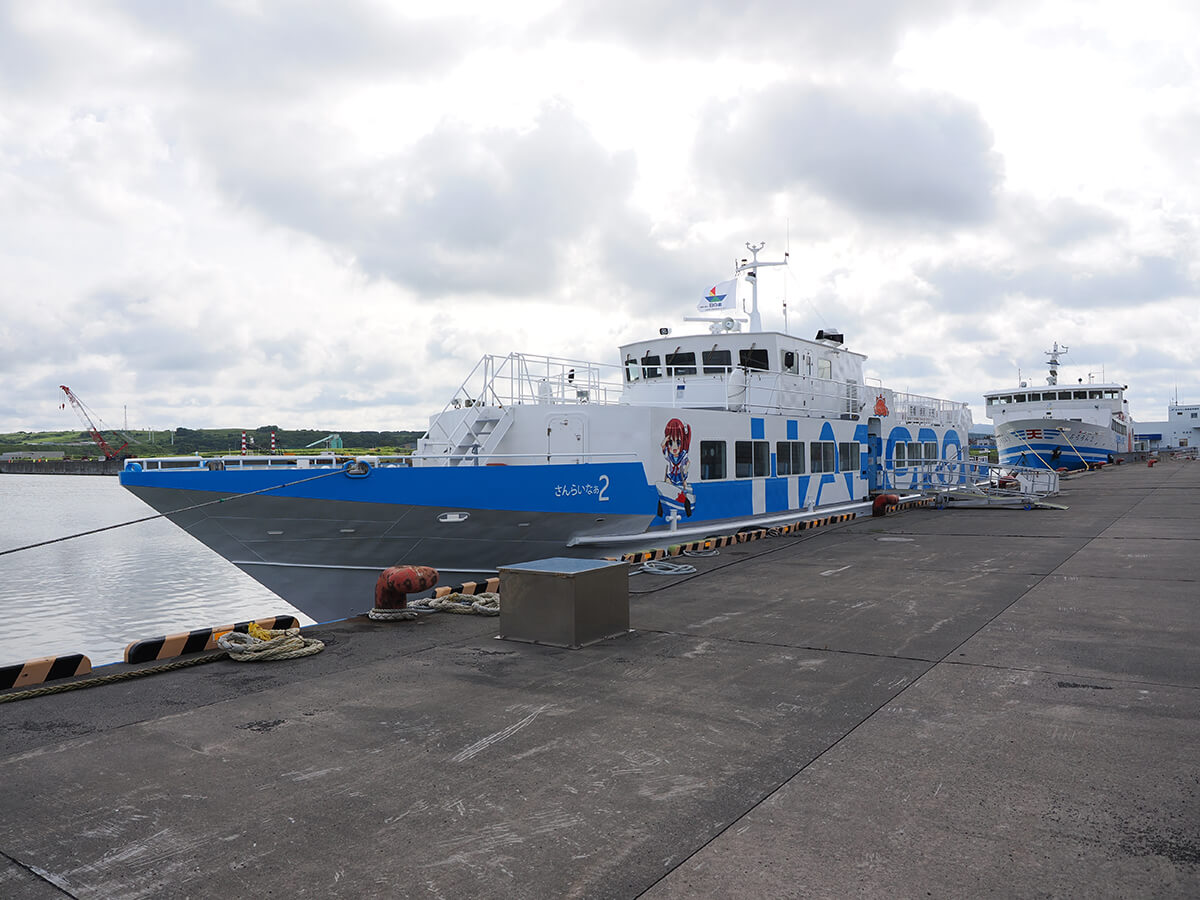
M.ZUIKO DIGITAL ED 12-40mm F2.8 PRO II/OM SYSTEM OM-1 Mark II/Equivalent to 24mm (35mm format equivalent)/Aperture priority AE (F4.0, 1/1,600 seconds)/ISO 200/WB: Auto/Picture Mode: Vivid
I boarded the first-morning highway boat "Sanrai Nai 2". In the back of the photo you can see the ferry "Ororon 2."
Temi Island is a place where you can observe rare seabirds, such as the sparrows that only live in Hokkaido and the coast of the Sea of Okhotsk, the sea sparrows (an endangered species), whose calls are the origin of the name Ororon line, and the doting island where Temi Island boasts the largest number of breeding numbers in the world. In fact, it is quite easy to get there by Haboro Coastal Ferry in Haboro on the Ororon Line.
Depending on the season, there are about 6 highway boats or ferries that run from one round trip to six round trips per day, with Haboro to Yakishiri Island to Temijima routes for about 35 to 60 minutes from Haboro to Yakishiri Island, and Haboro to Temijima to Temijima routes for about 60 to 100 minutes from Haboro to Temijima. You can definitely check the Haboro Coast Ferry for flight schedules and fares details
Another important point is that if you have a second class seat on the ferry, you can go to Temijima for just 2,500 yen. I went there in July and August, which was the highest season, so it was 2,520 yen, but the lowest price from June to September is 2,330 yen (as of August 2024). Depending on the flight schedule, in high season, you can take the first flight in the morning and return on the last flight, which is also possible for a day trip.
Walking around Temijima, about 12km arc, with OM SYSTEM "OM-1 Mark II" and a large three-man lens
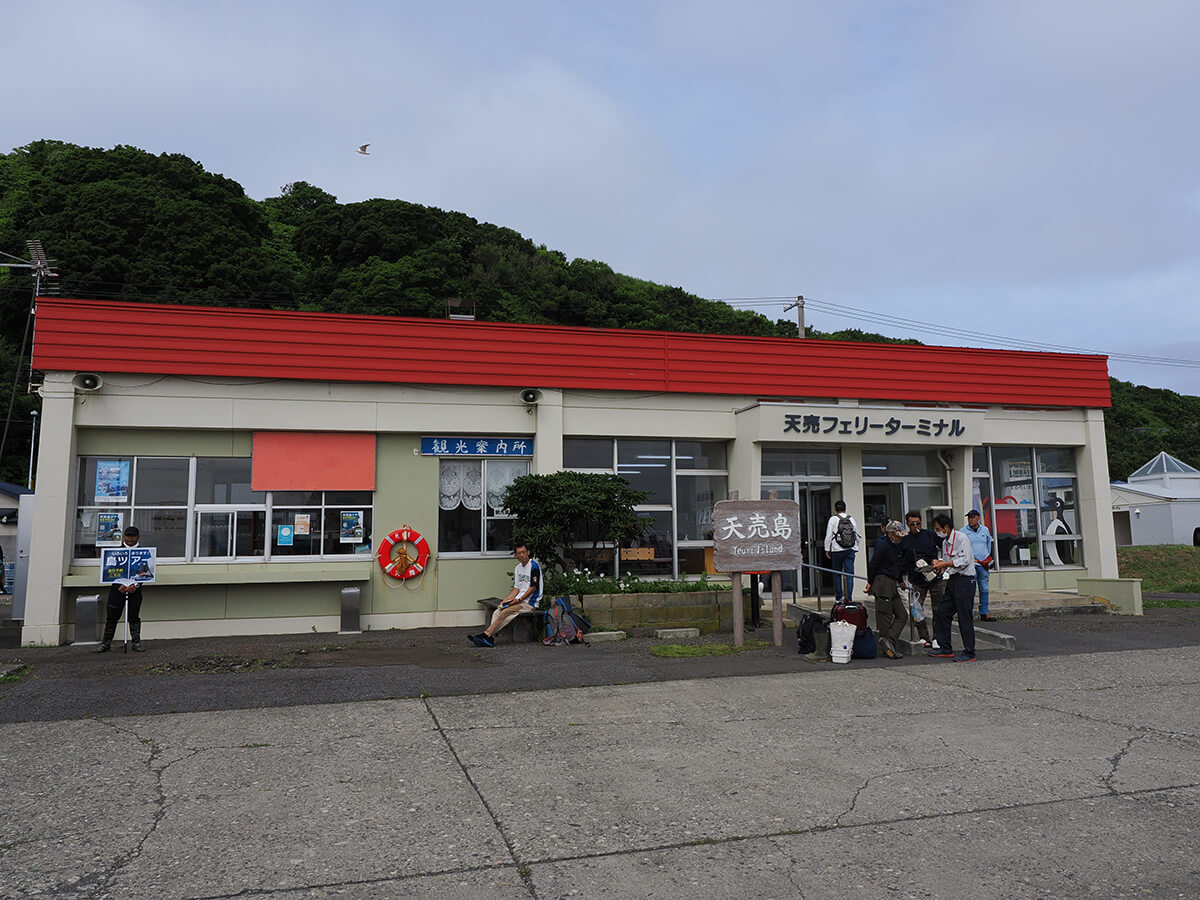
M.ZUIKO DIGITAL ED 12-40mm F2.8 PRO II/OM SYSTEM OM-1 Mark II/Equivalent to 24mm (35mm format equivalent)/Aperture priority AE (F7.1, 1/1,000 seconds)/ISO 200/WB: Auto/Picture mode: Vivid
Temai Ferry Terminal. I have never visited a remote island much, but it has an extraordinary feel to its foreign side. The tension rises.
Temijima is a paradise for seabirds, but it is said to be around about 12km. Many pamphlets say it's about 3 hours, but the author was expecting to spend about twice as long as he was taking photos. This time, I brought the OM SYSTEM "OM-1 Mark II" which I overwhelmingly trust in its mobility, plus a large three-way lens, and a teleconverter that is twice as large, but with these cameras and lenses, it costs less than 3kg even if you put the lens hood and cap in it.
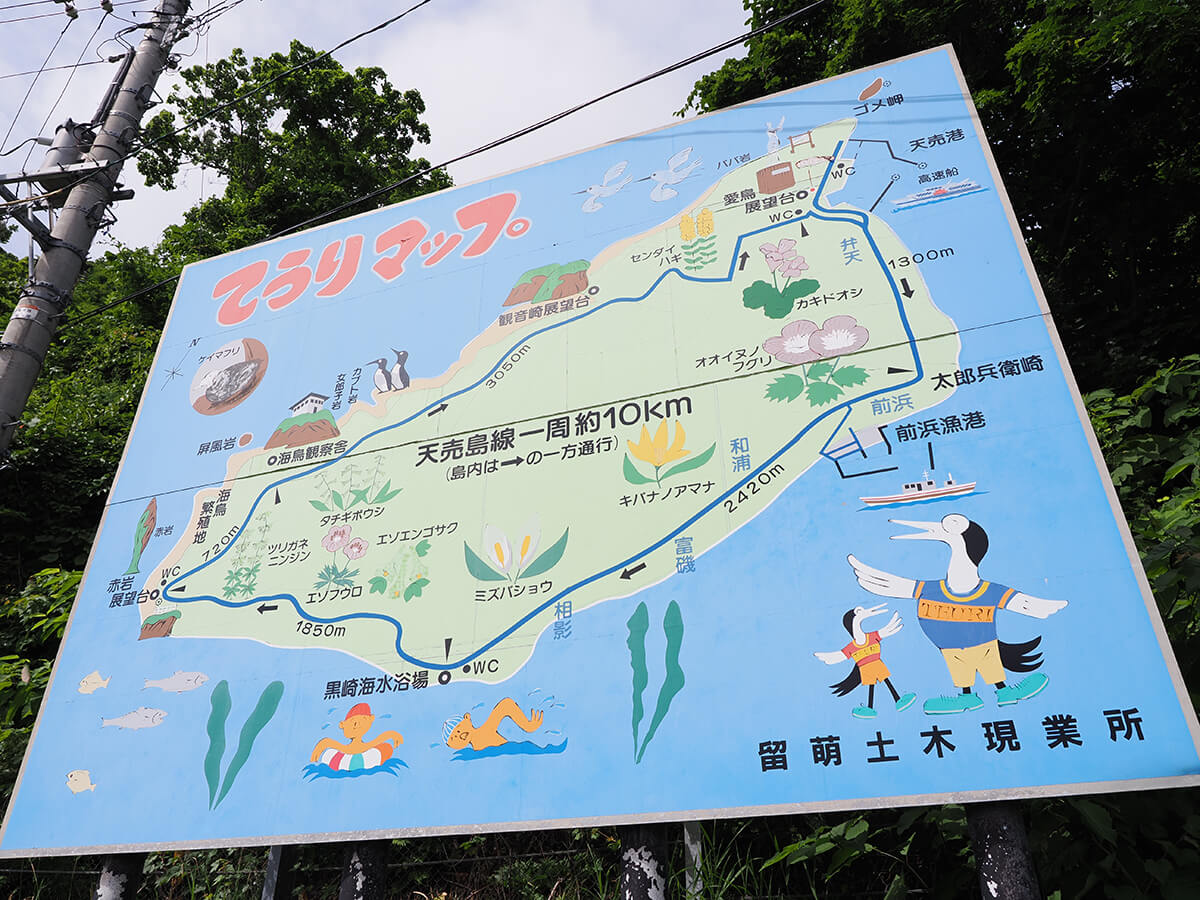
M.ZUIKO DIGITAL ED 12-40mm F2.8 PRO II/OM SYSTEM OM-1 Mark II/Equivalent to 24mm (35mm format equivalent)/Aperture priority AE (F4.0, 1/3,200 seconds)/ISO 200/Exposure compensation: +0.3EV/WB: Auto/Picture mode:
A fresh map posted widely on the Vivid road. The Temi Line seems to be about 10km per lap. After walking around the island, my smartwatch finally showed about 15km.
If you prepare equipment that covers 14mm to 600mm equivalent on a 35mm full-size system, it will easily exceed 5kg, so this heavy advantage is large. Also, if you include not only a camera and lens, but also a tripod and a photo filter, in my case it also contains rain gear and other foods, but the entire camera bag weighs about 8kg.
It seems like it would be quite difficult to hear about a trekking course in the middle of summer, carrying an 8kg of luggage. However, with a full-size 35mm system, the size of camera bags and other items will increase, and in some cases the load will be over 10kg, or even 12kg, so as for me, I feel that the OM SYSTEM "OM-1 Mark II" + large ternary lens system has an overwhelming advantage when shooting while walking.
I've also been able to photograph Ororon birds (sea glass), which are on the verge of extinction.
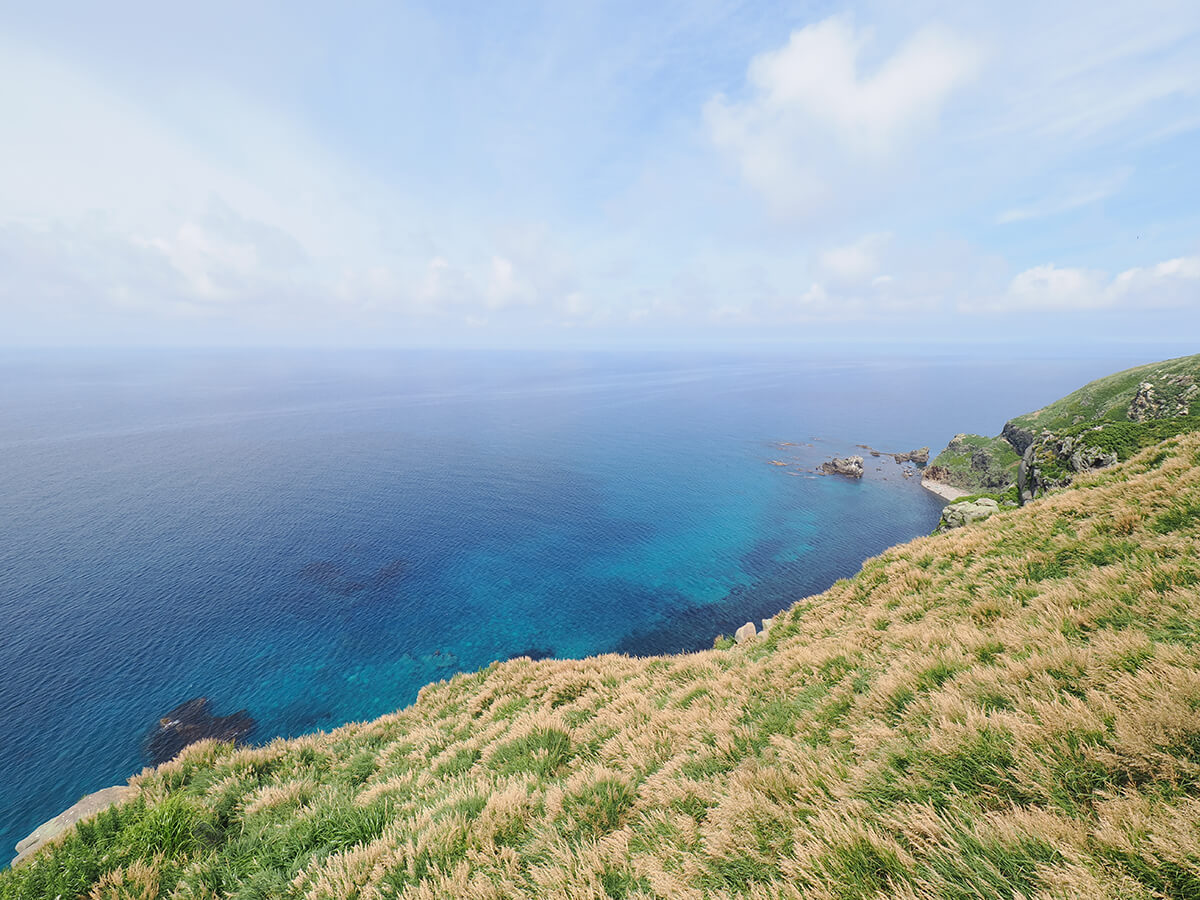
M.ZUIKO DIGITAL ED 7-14mm F2.8 PRO/OM SYSTEM OM-1 Mark II/Equivalent to 14mm (35mm format equivalent)/Aperture priority AE (F8.0, 1/320sec)/ISO 200/Exposure compensation: +0.7EV/WB: Auto/Picture mode:
A view from Vivid Akaiwa Observation Deck. Just looking at the scenery from this observation deck makes it a spectacular view that makes you feel worth coming to Temijima. It's an incredible sense of exhilaration.
I visited Temijima, which is also known as a paradise for seabirds, thinking this time it was just a reconnaissance, but I was surprised at how many birds there were during the trekking. Moreover, on the observation deck overlooking Akaiwa, one of the highlights of Temijima, Temijima is the only breeding ground in Japan, and in 2010, they successfully photographed the endangered Ororon bird (sea crab), which has only been observed under 20 birds.
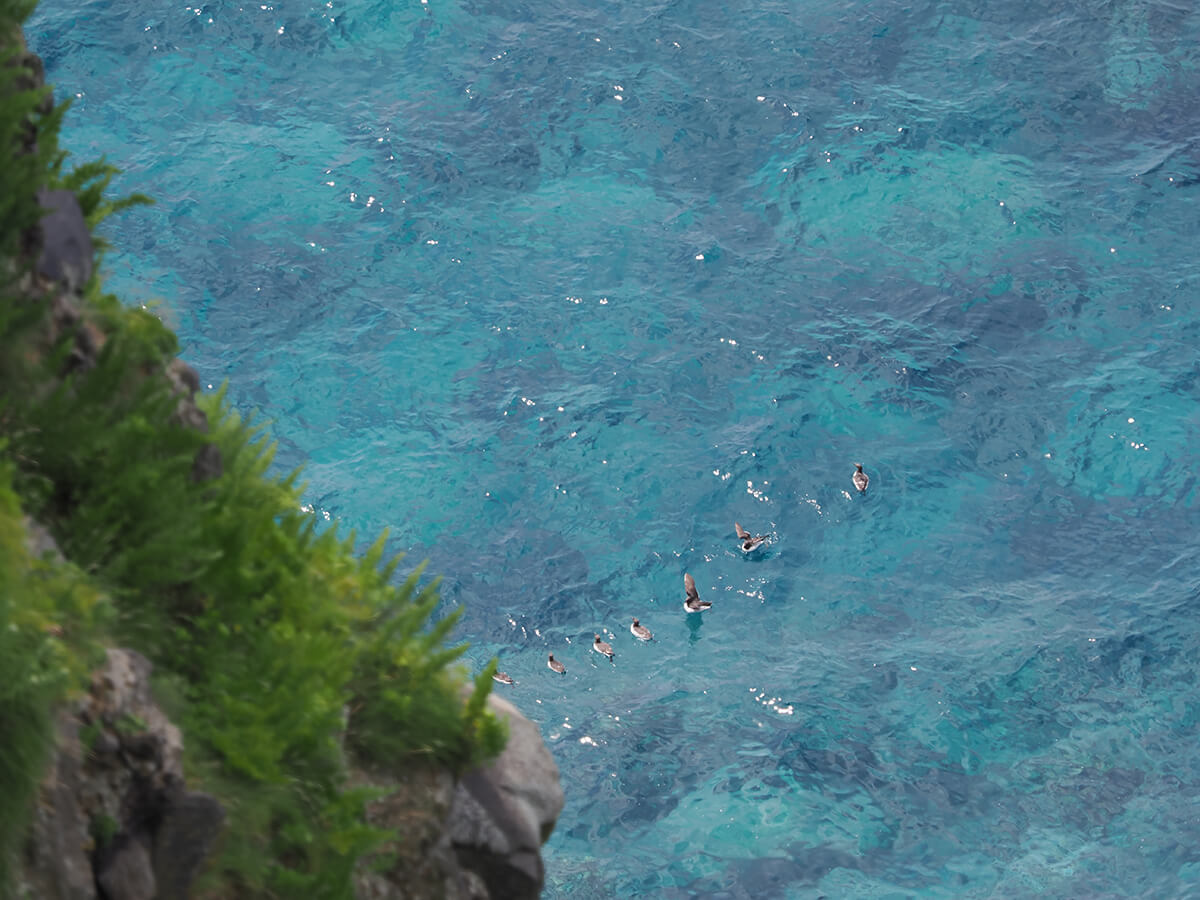
M.ZUIKO DIGITAL ED 40-150mm F2.8 PRO + M.ZUIKO DIGITAL 2x Teleconverter MC-20/OM SYSTEM OM-1 Mark II/Equivalent to 600mm (35mm equivalent)/Shutter speed priority AE (F5.6, 1/500 seconds)/ISO 200/WB: Auto/Picture Mode: Vivid I
was able to take pictures at the level of "There's a bird I've never seen before." It is an extremely rare and endangered species.
When I happened to be taking photos at the Akaiwa Observation Deck, it seems that the Ororon bird (sea glass) was taken at the level where "there are birds I've never seen before, so I'll take a photo since I'm here." I have no ability to identify ororon birds, but the nature guide who happened to be present saw a flock of the same birds and explained it was an ororon bird, so I think it's almost certain.
I visited Temijima in the second half of July, so although it was a bit off the season, I was able to enjoy the Ororon birds and young sea cats. We also had a great environment where we could observe many bluefin swallows and giant seagulls.
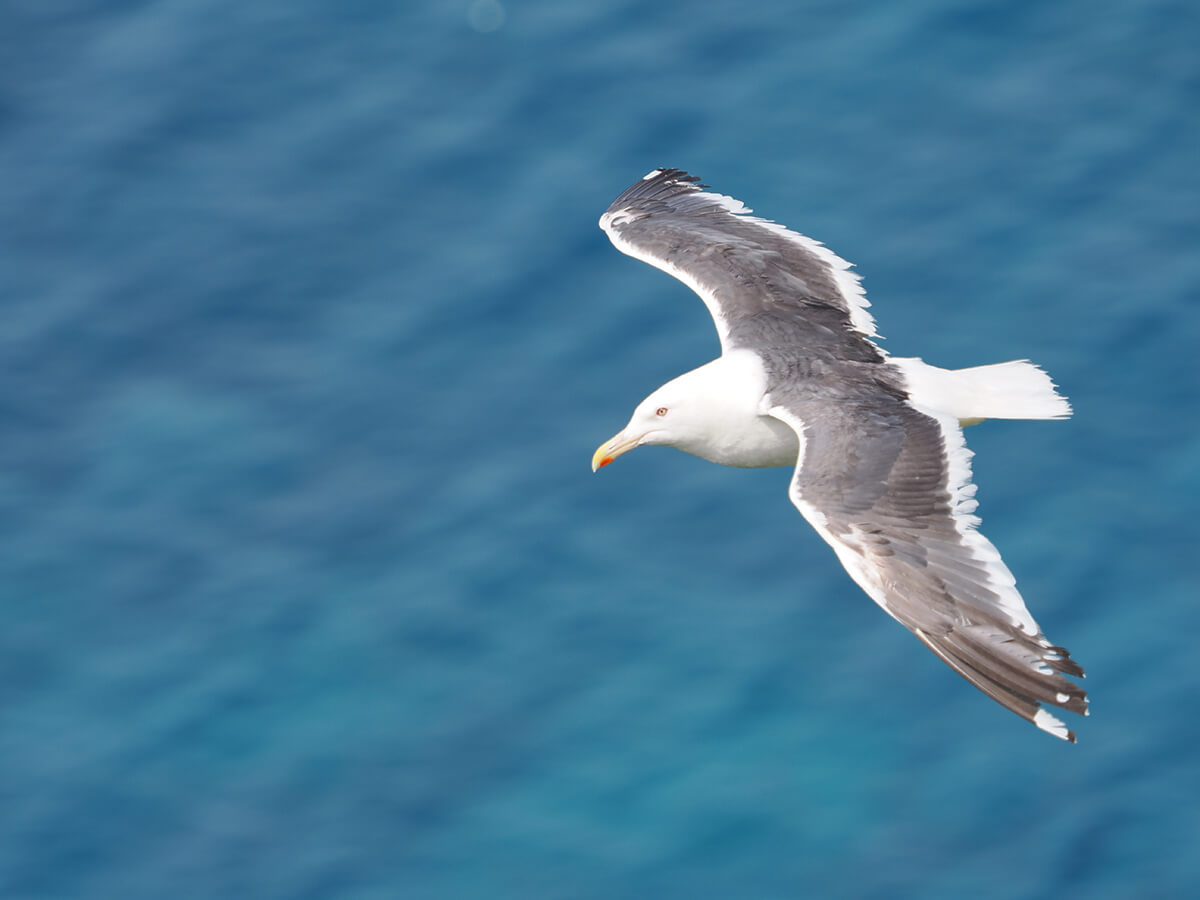
M.ZUIKO DIGITAL ED 40-150mm F2.8 PRO + M.ZUIKO DIGITAL 2x Teleconverter MC-20/OM SYSTEM OM-1 Mark II/Equivalent to 600mm (35mm format equivalent)/Shutter speed priority AE (F5.6, 1/1,000 seconds)/ISO 320/WB: Auto/Picture mode: Vivid
600mm equivalent, with note trimming. There are many birds, so you can take photos with a telephoto lens from various angles. The AF tracking of AI subject recognition AF feels great.
It's so much fun, I'd like to stay overnight in June next season
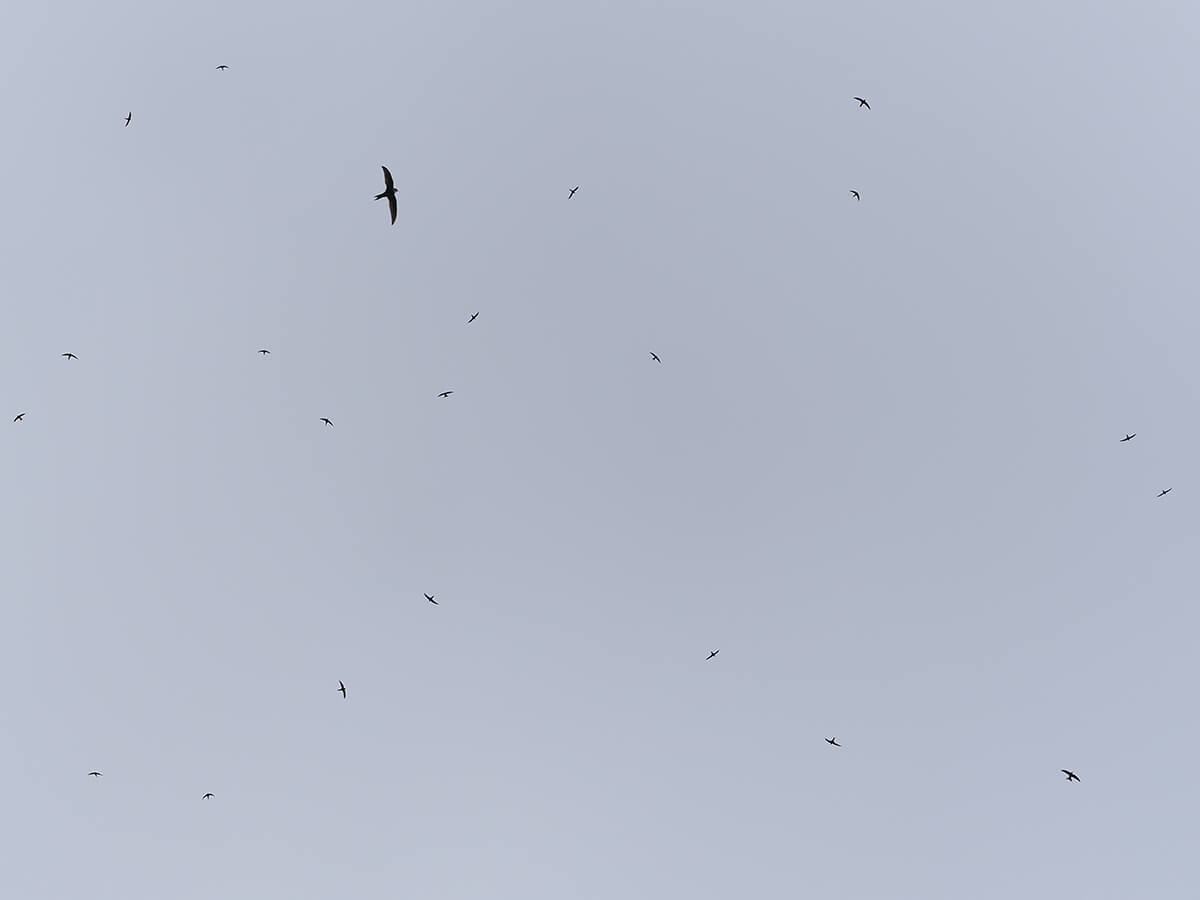
M.ZUIKO DIGITAL ED 40-150mm F2.8 PRO + M.ZUIKO DIGITAL 2x Teleconverter MC-20/OM SYSTEM OM-1 Mark II/Equivalent to 160mm (35mm format equivalent)/Shutter speed priority AE (F10, 1/1,000 seconds)/ISO 200/WB: Auto/Picture Mode: Vivid
Even when shooting with a telephoto equivalent to 160mm, over 20 swallows will be visible on the screen. Temijima is surprisingly dense in birds.
The scenery from the Akaiwa Observatory, near the southwest edge of the island, about 5km from the Temi Ferry Terminal, was truly amazing, and after taking a picture of the landscape, I enjoyed taking pictures of the seagulls and swallows flying around incredibly many.
The OM SYSTEM "OM-1 Mark II" used this time allows you to target birds' eyes with AI subject recognition AF, or the "M.ZUIKO DIGITAL ED 40-150mm F2.8 PRO" that you've brought with you this time, but it has a function that's very suitable for shooting birds and wildlife, such as a pro-capture function that allows you to record up to 99 frames from half-pressing the shutter button to full-pressing the shutter button.
The main subjects were Ororon birds and seagulls that I happened to be able to photograph, but the filming with the "OM-1 Mark II" + "M.ZUIKO DIGITAL ED 40-150mm F2.8 PRO" and "M.ZUIKO DIGITAL 2x Teleconverter MC-20" made me feel good about the decisive moments.
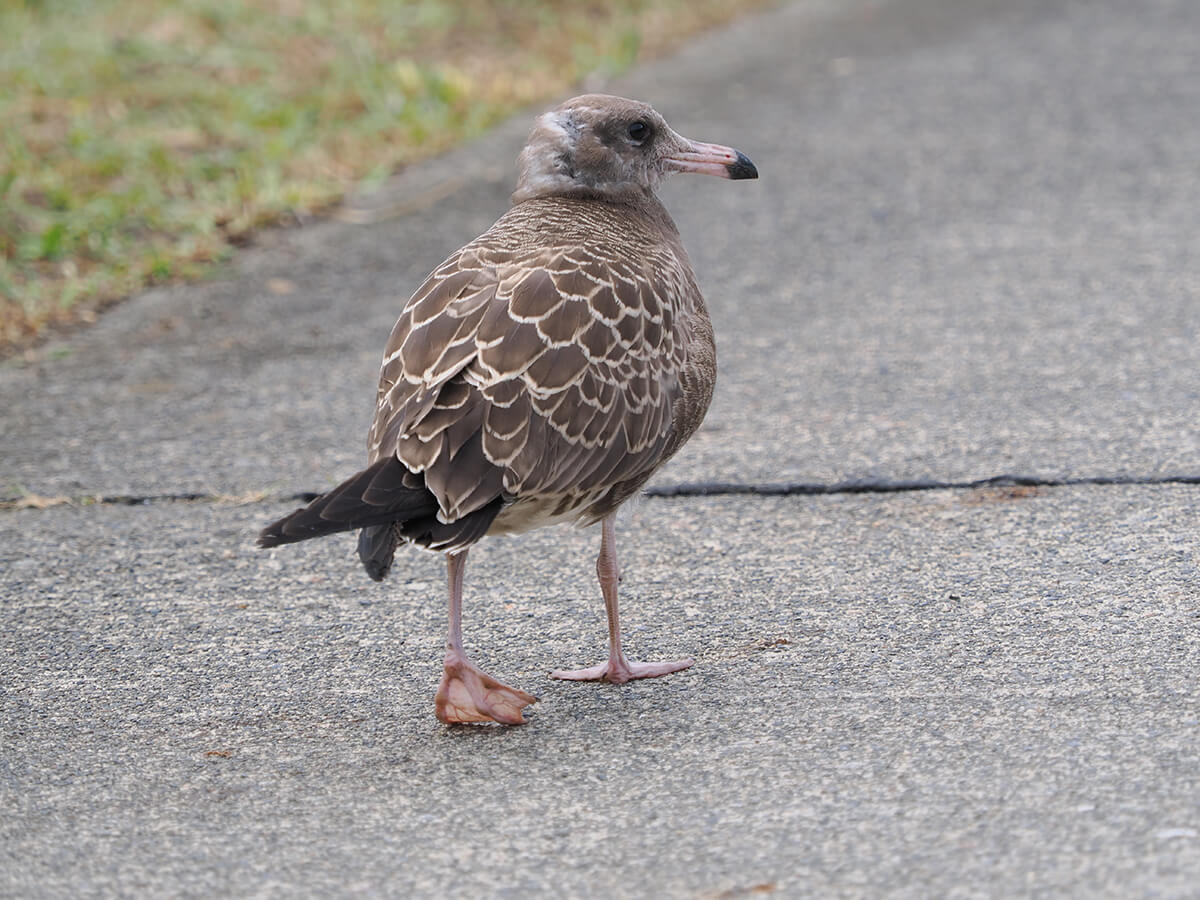
M.ZUIKO DIGITAL ED 40-150mm F2.8 PRO + M.ZUIKO DIGITAL 2x Teleconverter MC-20 / OM SYSTEM OM-1 Mark II / Equivalent to 160mm (35mm format equivalent) / Shutter speed priority AE (F5.6, 1/1,000 seconds) / ISO 500 / Exposure compensation: +0.3EV / WB: Auto / Picture mode:
I often saw young vivid seagulls walking in front of me while walking around the island, perhaps because it was a hassle to fly.
Unfortunately, it was a bit disappointing that the rare Ororon birds, such as the sparrow birds, the sparrow and the dove, were not able to participate in the tour as the dove was hoisted after the last ferry flight. As a resident of Hokkaido, I am thinking of trying again next season, but I think it would be better for those visiting from outside Hokkaido to stay overnight on a tour where you can meet rare seabirds.
The author is planning to take his family to stay overnight next season, including Yakishiri Island, and try again at Temijima. Even though I, a resident of Hokkaido, I was so moved that I thought that Temijima, a remote island in Hokkaido, was a completely different world. It is highly recommended.
Summary: OM SYSTEM "OM-1 Mark II" + Daisangen lens is perfect for adult adventures

This camera bag is designed to hold a single telephoto zoom lens for a full-size 35mm size. It's amazing that it can store cameras and lenses, as well as rain gear.
When you think about walking with your back, lightness is overwhelmingly justice
There are probably differences in individual differences and experience, but it is said that the weight of luggage for day trips and trekking is 10-15%, 60kg is 6-9kg for people who enjoy traverse mountain climbing in a tent, and 10-15kg for people who enjoy tracing mountain climbing in summer. Even excluding the weight of the tripod, filters, and the camera bag itself, it would be almost impossible to lower than 5kg when choosing a high-performance lens such as a large ternary lens that is intended to cover 14mm to 600mm with a full-size 35mm camera system.
However, the OM SYSTEM "OM-1 Mark II" + large three-way lens and double teleconverter that I brought with me this time reduces 3kg even when I put the lens hood or cap in it, and even covers 14mm to 600mm equivalent. Even if you put rainwear, food and water in your tripod, filters, or camera bag, you can easily keep your entire luggage at a rate of less than 9kg, allowing you to enjoy adventure, mountain climbing and trekking comfortably. If I hadn't covered up to an ultra-telephoto equivalent to 600mm with this heavy luggage, I wouldn't have gone to Temijima on my trip this time. In a sense, if the M.ZUIKO DIGITAL ED 40-150mm F2.8 PRO + M.ZUIKO DIGITAL 2x Teleconverter MC-20 had the OM SYSTEM OM-1 Mark II combination, it could be said that they would have decided to head to Temijima, an unknown land.
Even a 10kg rice bag feels heavy in everyday life, so unless you're training for that, it's a bit reckless to carry a camera system that includes a 35mm full-size, large three-way lens that will total weight exceed 15kg, and do mountain climbing or long-distance trekking. I usually try to run to build up my physical strength, but even so, walking around Temijima Island plus 15km with about 8kg of luggage was quite exhausting. When this luggage is said to be 1.5 times more weight, I would walk because it's work, but when it comes to my own fun, it's a bit tougher.
Unfortunately, cameras and lenses have also been rising in response to the recent rise in prices, and high-end cameras and lenses are also increasing in size. As a partner for adult adventures, OM SYSTEM's camera and lens system, centered around the OM-1 Mark II, is extremely attractive, with a moderate size, weight and priced quality. I feel that it's a 35mm full size, but why not add Micro Four Thirds' OM SYSTEM to your camera system options? I think it will greatly expand the range of adult adventures.
Furthermore, when I returned to Haboro by the final ferry from Temijima and checked the weather forecast to decide on my plans for the next one, unfortunately there was a good chance that the rain would be forecast throughout the entire area. The author returned to Chitose City that night, but if he was traveling, he could take his time to enjoy the local specialties at roadside stations. The Ororon Line in the summer is a driving course that you should definitely experience at least once. If you are visiting Hokkaido, remember this as an option.
Details and purchase of OM SYSTEM cameras and lenses
For more information about the product, please visit the official OM SYSTEM website
Please consider paying memberships that allow you to support the site while enjoying limited edition projects and content!
Saito Titoce
 Former monthly camera magazine editor. While pursuing the spectacular views of Hokkaido and the wildlife, I was completely hooked on the outdoor life of camper vans and sleeping in my car. While traveling the entire country with his 2-year-old son and wife, he is a photographer writer who photographs and writes everything he has experienced, not only cameras and lenses, but also outdoor camping, child-rearing, PC gadgets, cooking, and dieting. OUTDOOR GEARZINE plans to write a variety of articles, focusing on the QOCL (Quality of Camping Life) Improvement Committee, which will improve the quality of life in camping and camper vans.
Former monthly camera magazine editor. While pursuing the spectacular views of Hokkaido and the wildlife, I was completely hooked on the outdoor life of camper vans and sleeping in my car. While traveling the entire country with his 2-year-old son and wife, he is a photographer writer who photographs and writes everything he has experienced, not only cameras and lenses, but also outdoor camping, child-rearing, PC gadgets, cooking, and dieting. OUTDOOR GEARZINE plans to write a variety of articles, focusing on the QOCL (Quality of Camping Life) Improvement Committee, which will improve the quality of life in camping and camper vans.



 [Light and small items are absolute justice outdoors! 】I took pictures of Naki rabbits at Mt. Hakuun and Mt. Higashi Nupukausinupuri for two consecutive days with "OM SYSTEM OM-1" and "M.ZUIKO DIGITAL ED 100-400mm F5.0-6.3 IS".
[Light and small items are absolute justice outdoors! 】I took pictures of Naki rabbits at Mt. Hakuun and Mt. Higashi Nupukausinupuri for two consecutive days with "OM SYSTEM OM-1" and "M.ZUIKO DIGITAL ED 100-400mm F5.0-6.3 IS". [High performance, lightweight, compact, and bright! 】5 reasons why "ZEISS Touit 1.8/32" is a high-end standard prime focus recommended for outdoor travel
[High performance, lightweight, compact, and bright! 】5 reasons why "ZEISS Touit 1.8/32" is a high-end standard prime focus recommended for outdoor travel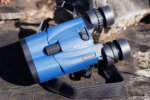 review kenko vc smart 15x42 cellarto wp
review kenko vc smart 15x42 cellarto wp [Makes walking around the forest trip three times more fun! 】Why the ZEISS Touit 2.8/50M is highly efficient for both macro and portrait photography, making it a great way to explore
[Makes walking around the forest trip three times more fun! 】Why the ZEISS Touit 2.8/50M is highly efficient for both macro and portrait photography, making it a great way to explore